A Leadership Series from Futurist Jim Carroll
Leading Through Uncertainty
It is what it is. We are where we are.This moment in 2025 feels like a bad dream to many, and the assault on the global economy has been a tipping point for many worldwide.With that in mind, Futurist Jim Carroll wrote a series addressing a number of key questions:* How do we lead through uncertainty? How do we lead ourselves - what's our mindset? How do we lead others - how can we help them? How do we lead our organizations - how do we keep moving forward?*Jim spent a lot of time on this theme during and after the downturns of 2001, 2008 and again during 2020, speaking about leadership resilience at events worldwide.There is a lot to revisit, and a lot to think about. The theme is 'resilience,' and we can all learn more about what it means, and what we can do to keep focused on where we can go - not just where we are.
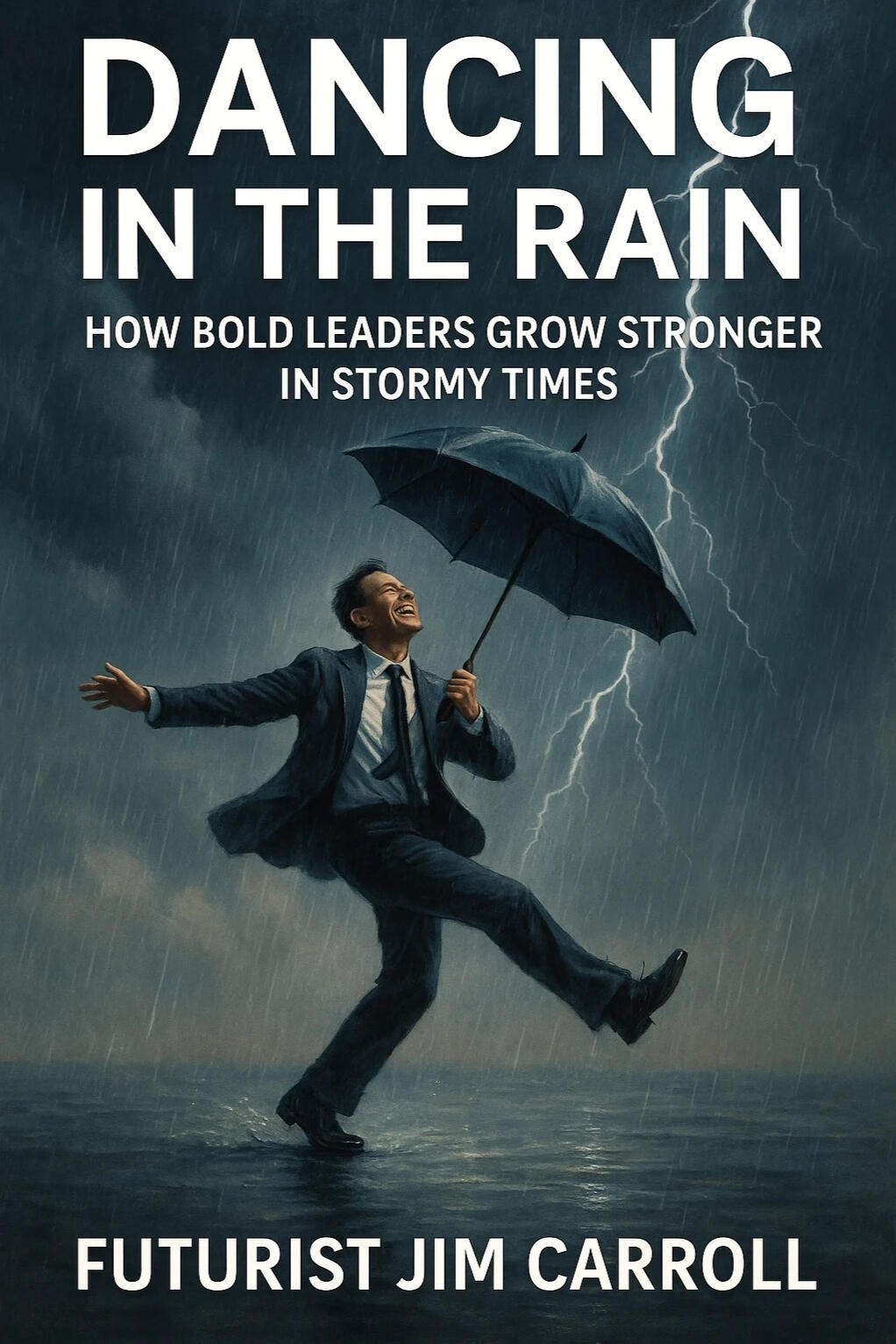
The material in this series is now the focus of Jim Carroll's book, Dancing in the Rain: How Bold Leaders Grow Stronger in Stormy Times.Released in June 2025, the book is now avaialble for sale. Learn more at dancing.jimcarroll.com
#1 - April 7, 2025
The long arc of the future always rewards the patient!
We’re living through an era where it feels like the very idea of progress is under siege.Science is questioned. Facts are ignored. Bold ideas are met with backlash. Funding is cut. In parts of the world—especially in the U.S.—there’s a growing, dangerous desire to rewind the clock. It’s an effort to return to some imaginary "better time," rather than confronting the future with the courage and creativity it demands.And yet—despite it all—the future hasn’t stopped moving forward.

You can delay progress. You can defund it. You can deny it. You can hammer it with ill-advised or even idiotic decisions.But you can’t delete it.Never forget that fact, and act accordingly.Don't give in. Don't give up. Don't give way.The long arc of innovation always bends forward. History is clear on this: the future always finds a way. Whether it’s AI revolutionizing how we work, precision medicine reshaping healthcare, or microgrids powering cities like Nairobi —the ideas are still unfolding. Just not always where you expect.It’s tempting, especially now, to be disillusioned. To believe the cynics are winning. To think progress is on pause. It's easy to let fear strike us every day, stunning us into frozen disbelief.But don’t confuse noise for momentum. The future doesn’t follow headlines. It follows courage, capital, and conviction. And all three are still alive and well—albeit a bit battered and bruised. But they are still there.As a futurist, I’ve always said the future belongs to those who are fast. But today, I’d add this: it also belongs to those who refuse to flinch.If some people want to step back from the future—that’s their choice.You? Step forward. The future is still yours— ours— to build.So how do we build this future in the face of resistance? What do we do at this very moment, as global equities give their negative verdict on where we are?It begins with mindset. Embrace resilience—don't flinch when faced with setbacks but adapt quickly. Keep your focus on long-term progress while taking decisive action today. Ground yourself in your core purpose, even during uncertain times. And throughout it all, maintain unwavering optimism that acknowledges challenges while recognizing our capacity to overcome them.The future has always belonged to those who refuse to look backward. Now it's your turn to lead it forward.Progress endures despite volatility.Tomorrow belongs to the believers.Hang in there.
#2 - April 8, 2025
In times of chaos and fear, purposeful action is power
Act boldly. Fear feeds on hesitation.Think about this moment. Confidence is fragile. Every headline screams volatility.And just like that, a wave of fear rolls in—bringing hesitation, doubt, and paralysis.Are you letting the fear freeze your future?Have you become the deer in the headlights?But here’s the truth: the antidote to anxiety is action.While others freeze, you can move.
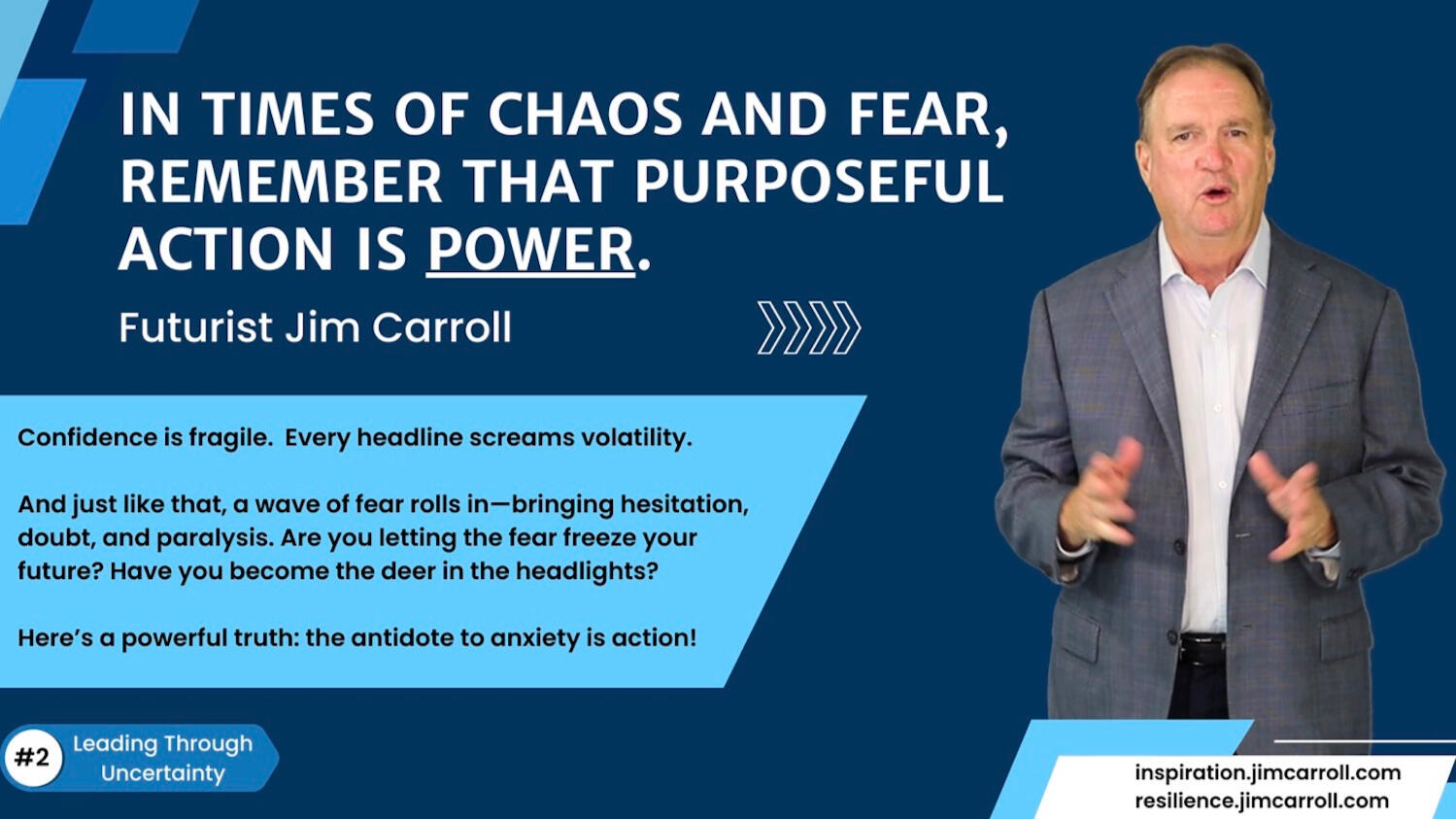
While some debate what might go wrong, you can start building what could go right.While people wait for signs an upturn, you can create your own little upturn, simply by acting.Fear loves hesitation. It grows stronger when you pause, wait, scroll endlessly, or convince yourself that “now isn’t the time.” It thrives in your indecision, matures in the recesses of your uncertainty, and becomes a cancer in your inaction.But bold action—no matter how small—immediately puts you back in the driver’s seat. It shifts your mindset from ‘overwhelmed‘ to ‘engaged.’ It puts you in control. It gets you out of your doom cycle. It brings you back from focusing on where you are – to building momentum for where you could be.You don’t have to launch a moonshot to make a difference. You don’t need some huge stretch goal. You don’t need to be chasing some grand vision. You just have to move:Learn something new.Start that project.Test the idea.Build the prototype.Say yes.Momentum beats perfection. Progress quiets panic. Action beats fear.We are not victims of the future. We are its architects—if we choose to be.So when the uncertainty rises, meet it with motion.When fear whispers “not yet,” answer back: “Watch me.”Because the future doesn’t wait.And neither should you.What are you waiting for?
#3 - April 9, 2025
If you want to be part of what’s next, leave your nostalgia at the door.
You need to commit.Yesterday, or tomorrow?I know where I'm going. It's in my job description.Think about it - at this very moment, we’re witnessing a battle playing out everywhere—across boardrooms, governments, industries, at parties and sports events and family get togethers. The battle is being driven by a vainglorious and ill-fated desire to try to take things back to where they were - not to where they are going.And one of the most important things you need. to do is make your decision - and stick to it - as to where you are headed.It's a battle of vision vs. nostalgia.Of strategy vs. sentimentality.Of building what’s next vs. longing for what was.It's really not a fair fight.
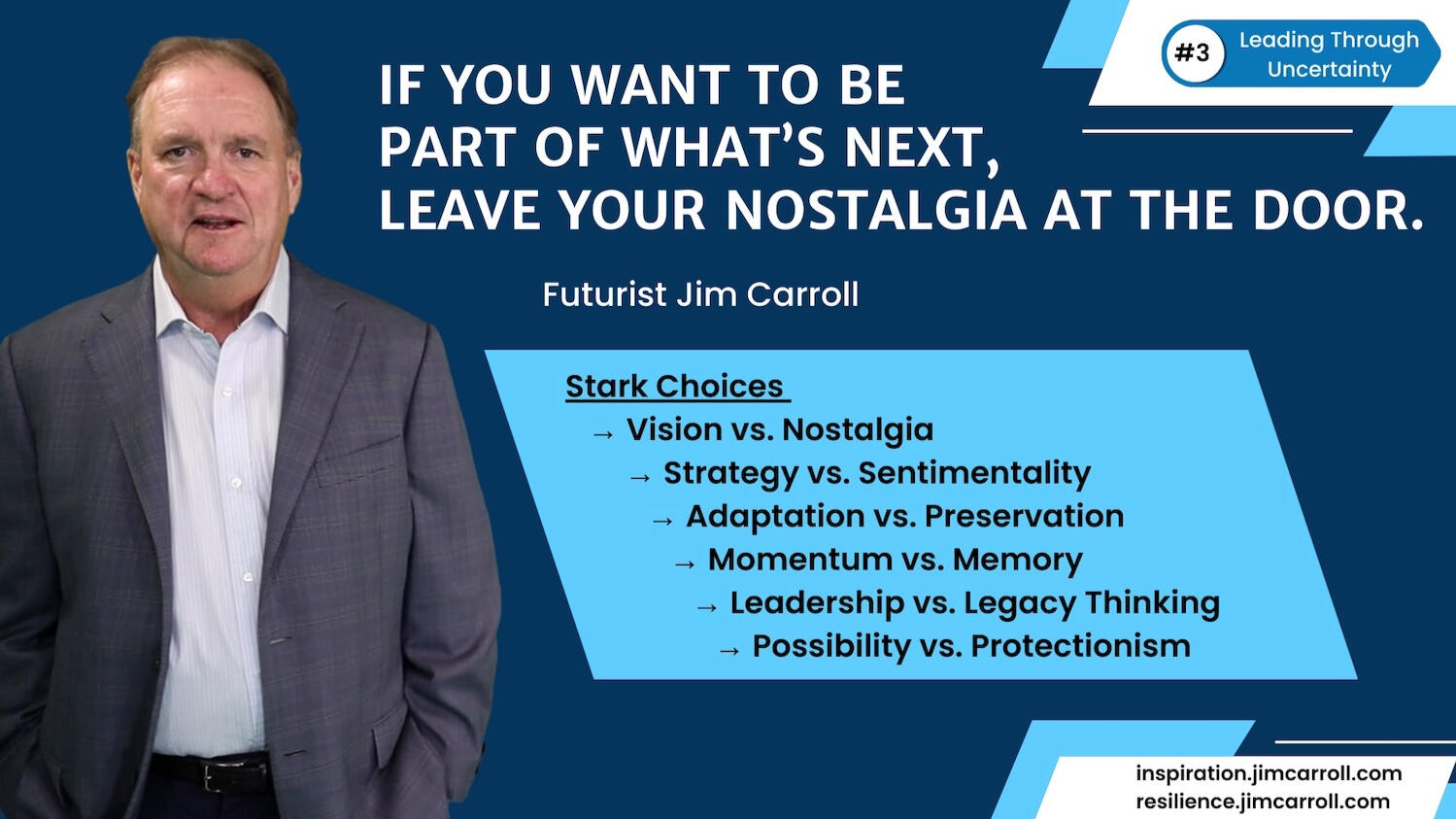
We’ve reached a point where the familiar is failing - old industries are dying, old skills are becoming irrelevant, old knowledge is going out of date, old jobs are disappearing. In the context of that? New industries, skills, knowledge, jobs - and new opportunities.It's called disruptive change, and it is very real. The new rule is that older stable ideas aren’t stable. Playbooks that were once reliable aren’t playable. Assumptions and strategies that served the past no longer serve the future. The fact is, the world’s moving faster than our old systems were designed to handle.And yet—some still cling to the comfort of past success like it’s a security blanket.But nostalgia is not a strategy. It’s a sedative.In a world that demands reinvention, clinging to the past is a slow form of decline.If you want to lead your team, your business, or even yourself through this moment, the answer isn’t to “get back to normal”—it’s to get better at what’s next.We now know what works:
businesses that embrace change and actively adapt their models during crisis (anti-fragility) bounce back stronger.
leaders who let go of the expectation to “have all the answers” and instead lean into learning, agility, and reinvention are that find the new answers
companies that invest in innovation—process, product, and purpose—capture opportunity while others fall behind
olong-term success is built by those who protect future-facing investments like R&D, automation, digital, and customer insight—even when it's tempting to cut them.
Look at the companies that missed the future—Kodak. Blockbuster. Blackberry. Their downfall wasn’t a lack of resources. It was a devotion to the past that blinded them to the signals of change. When you think about it, that's exactly what is happening at this moment in time with Tesla - with their CEO so caught up in fighting a different battle that has ceded the future of electric vehicles to China.Recessions and disruptions are not the time to shrink your ambition. They’re a time to reshape it.So ask yourself: Are you holding onto what used to work—or reaching for what could?The future doesn’t wait for comfort. It rewards courage.And if you want to be part of what’s next, leave your nostalgia at the door—and bring your blueprint for tomorrow. That's because this moment isn’t just about letting go of nostalgia, it's about trading old mindsets for future-ready ones:
Vision vs. Nostalgia – Stop looking back. Start looking ahead.
Strategy vs. Sentimentality – Reality over drama. Direction over emotion.
Adaptation vs. Preservation – Evolve or risk irrelevance.
Momentum vs. Memory – Motion matters more than history.
Leadership vs. Legacy Thinking – Reinvent the rules—even the ones that made you.
Curiosity vs. Complacency – Exploration fuels relevance. Routine kills it.
Possibility vs. Protectionism – The future doesn’t reward playing it safe.
If you’re still trying to bring back the past, you’re already behind.The future belongs to those who are ready to reshape it—one decision, one mindset shift, one bold move at a time.Leave your nostalgia at the door. And walk into what’s next.
#4 - April 10, 2025
Inertia feels safe. Until it isn’t. Innovation feels risky. Until it wins
Uncertainty rewards the inventive , not the indifferent.Recessions test everything—strategy, structure, and above all, mindset.You are going through all that right now with the wild whiplash of this moment in time. You can’t easily define strategies straight in a world in which one moment the world is up and the next is down. You can’t figure out a path forward when the path keeps changing. You can’t plant a flag on a foundation of certainty where there is none.But what you can do is commit to investing in your future through innovation.
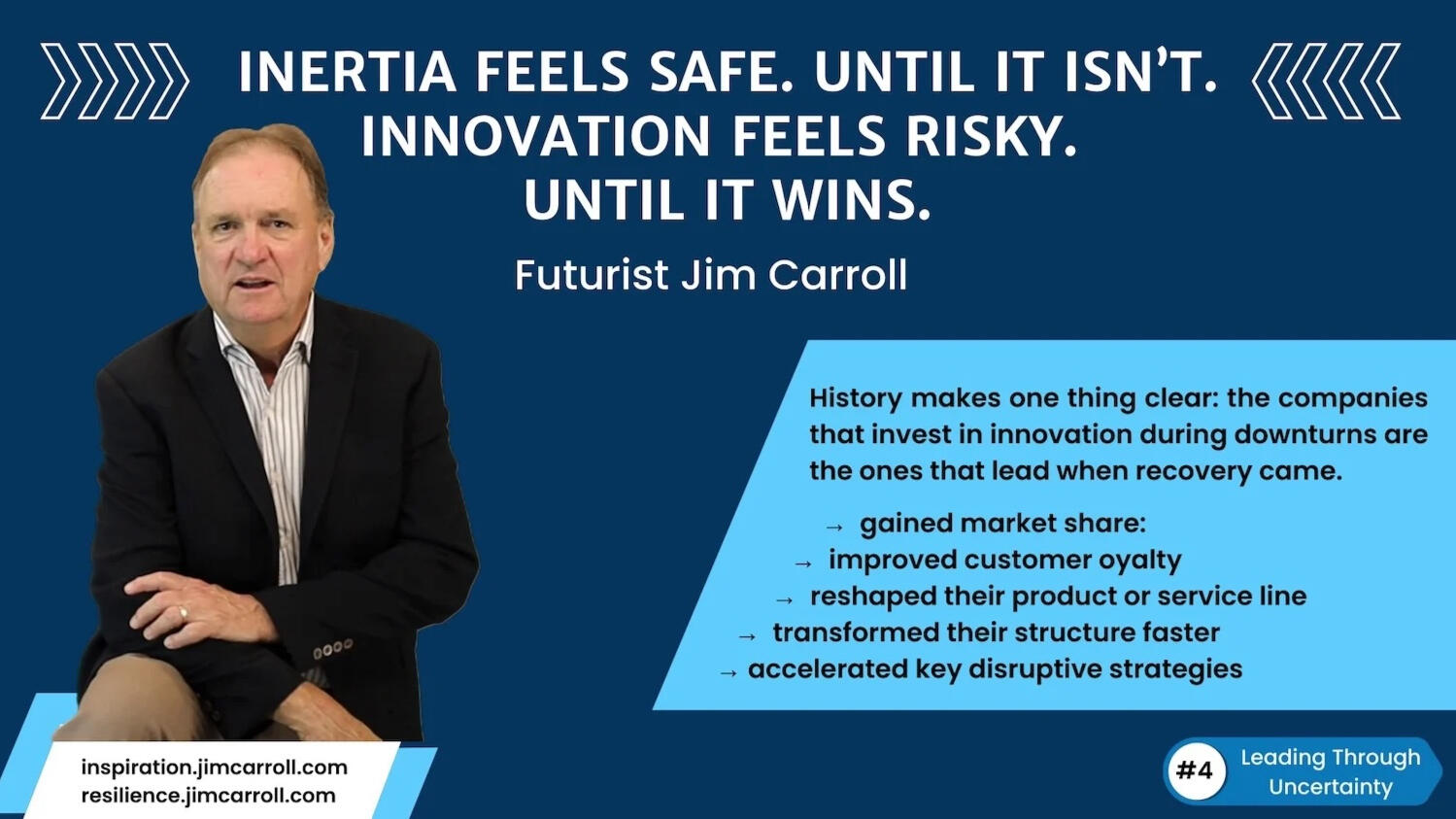
Think about it – when the world turns volatile, most companies do the typical thing – they freeze. They cut everything. Delay everything. Protect what was. Go into a mode of delay. But others take a different route: they innovate—not recklessly, but intentionally. They adapt their offerings, reframe their markets, and lean into change.History tells us who wins.In past downturns, the most resilient companies continued to invest in R&D, product development, and digital transformation, even as they restructured costs elsewhere. They embraced frugal innovation—creating smarter, leaner, more relevant solutions with limited resources. They used the moment to reimagine offerings for evolving customer needs—meeting people where they were, not where they used to be.They didn’t innovate in spite of the crisis. They innovated because of it.These companies weren’t reckless. They were strategic.They protected the core but invested in the future.They used volatility as a forcing function to rethink how they deliver value—and to whom.And the results speak for themselves – they:
captured market share: Outpaced competitors by staying relevant during volatility.
deepened customer loyalty: Met changing needs with smarter, faster solutions.
reimagined offerings: Pivoted products and services to fit the moment.
streamlined structures: transformed operations to move with greater speed.
accelerated disruption: Fast-tracked innovation that would’ve taken years otherwise.
Meanwhile, those that chose inertia? Most never caught up. Because innovation isn’t a luxury for good times. It’s a necessity for what comes next.In the end, volatility favors those willing to reinvent—while inertia quietly takes the rest out of the game.Which side of the curve will you be on?
#5 - April 11, 2025
Be a time traveller. Manage today’s crisis. But strategize for tomorrow.
Downturns are not just economic events.They are stress tests for leadership.When pressure builds, plans unravel. Priorities scatter. Noise takes over. People panic. That’s when some leaders retreat—shrinking their vision, delaying decisions, or hoping someone else will take the next step. But others stay grounded. They hold the line—for their teams, their strategy, and their purpose.This is real resilience. Not slogans. Not survival But the ability to move across time—anchoring the present, while building for the future.
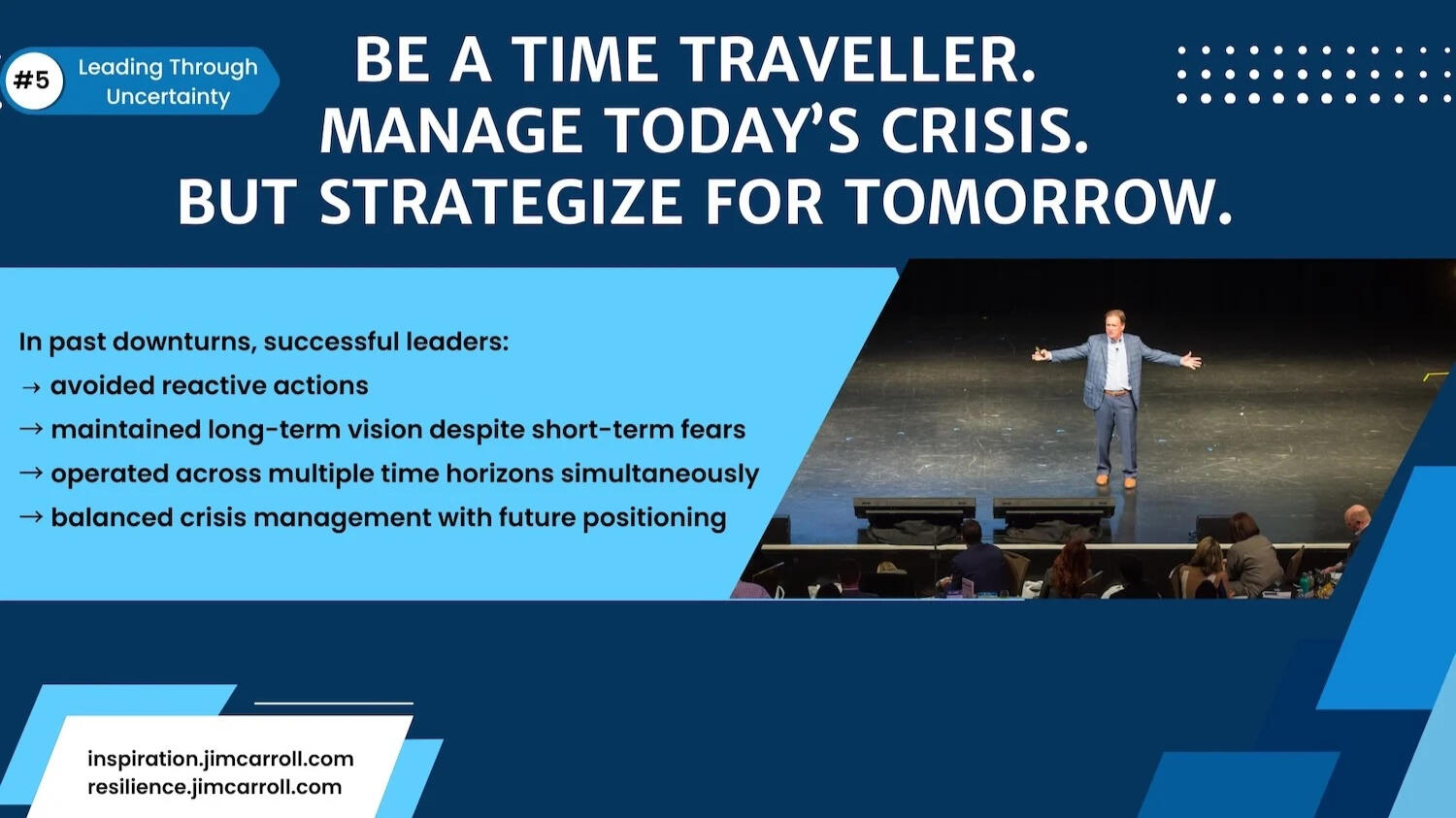
You have to be a time traveller: respond to the moment, while keeping your eyes locked on what comes next.Resilient leaders don’t just manage the current crisis —they hold it together until the future arrives.Here’s what the data shows from past downturns:
the most resilient organizations didn’t retreat into reactive cycles.
they didn’t discard their long-term vision under short-term fear.
they remained disciplined on costs and intentional on growth.
they protected their people, their customers, and their momentum—not just their margins.
Meanwhile, those that chose inertia? Most never caught up. Because innovation isn’t a luxury for good times. It’s a necessity for what comes next.In the end, volatility favors those willing to reinvent—while inertia quietly takes the rest out of the game.Which side of the curve will you be on?
The fact is, while they managed the crisis in real time, they never lost sight of the bigger arc.
they thought across multiple time horizons at once:
they actively manage today.
all while preparing for tomorrow.
and positioning for the rebound that always comes.
They didn’t flinch. But they didn’t charge blindly either. They led with calm, communicated with transparency, and made decisions that reflected long-term confidence—not panic.That’s the essence of future-ready leadership.So as the pressure rises, the question is simple: Are you retreating—or reinforcing? Are you in one time zone or several?Because the leaders who shape what’s next aren’t the ones with the boldest slogans. They’re the ones who stay clear, steady, and focused—while keeping one foot in the future.Be a time traveller. Manage the crisis.But never stop building what’s next.
#6 - April 14, 2025
The future rewards those who adapt under pressure, not those who break because of it.
Over the last five days, I’ve shared how we lead ourselves and our organizations through this moment of global volatility—one shaped by economic uncertainty, political instability, and cultural retreat from the future.Beginning by reaffirming belief in progress, even when it feels stalledConfronting fear with actionChallenging nostalgia with visionSpotlighting innovation as the antidote to inertiaEmphasizing the importance of thinking across time horizons—managing today while preparing for tomorrowBut there’s something deeper that sits underneath all of that: pressure..That’s the real test—managing this moment.
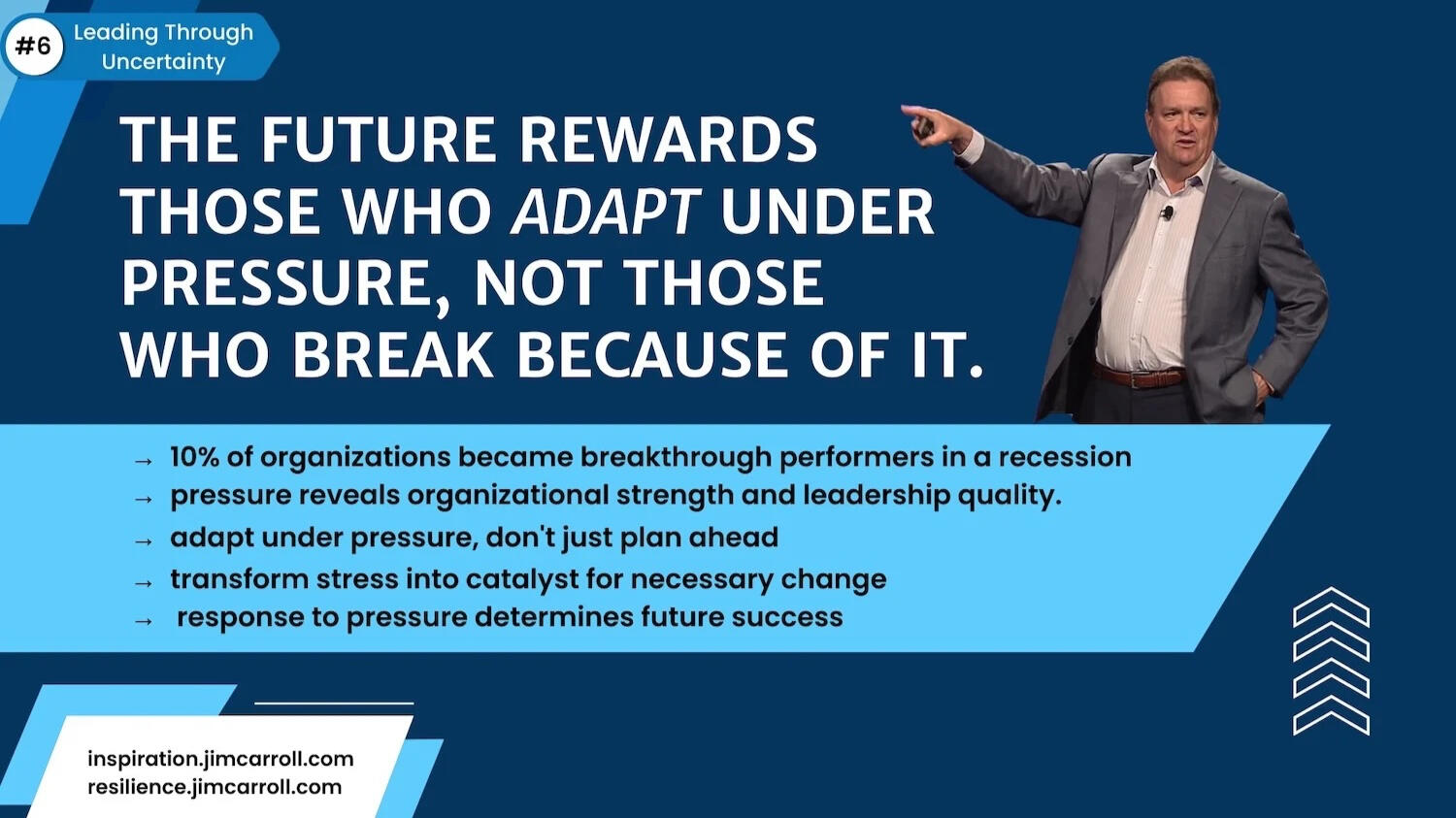
Keeping our heads on straight. Not letting the negativity consume us or define our future. If there’s one constant through every downturn, disruption, or crisis, it’s this: stress is the defining force of the moment. And how we respond to that stress—organizationally, personally, and strategically—determines whether we fall back, freeze up, or forge forward into what’s next.That’s why today, it’s not just about planning for the future.It’s about learning to adapt under pressure.Every moment of disruption applies pressure. And pressure reveals everything. It reveals which organizations and individuals have foundations that flex, and which ones crumble. It reveals leaders who focus forward—and those who fold under volatility.Right now, we’re not just navigating an economic downturn. We’re navigating a world defined by compounding stress—market stress, leadership stress, and system stress. But stress, when met with strategy, becomes fuel for the future.I’ve written about this before: “It’s in our response to volatility that our future is defined.”The most future-ready companies don’t panic. They channel pressure into progress. They don’t crumble under stress—they restructure, refocus, and realign. They transform pressure into precision—cutting noise, not capacity. They rethink agility, not just in structure but in mindset. They use stress as a forcing function—to do what needed doing all along.My advice is clear: You don’t rebuild your organization for the next crisis. You rebuild during this one—for the world that follows.Stress is unavoidable. But breaking is not.Your future hinges not on whether you face stress—but what you do with it.So when the tension rises, ask yourself:Are you absorbing it, reacting to it—or are you adapting through it?Because the organizations that thrive tomorrow are being stress-tested today.And the ones who rise are the ones who adapt under pressure, not break because of it.The future won’t be stress-free. But it will belong to those who grow stronger in the strain.
#7 - April 15, 2025
In a time of uncertainty, the future doesn’t slow down to give you time to make up your mind!
Uncertainty is not an excuse to stall. It’s a signal to move—strategically, swiftly, and with intent.And yet, in moments like this, indecision becomes the silent killer. Leaders delay. Organizations drift. People pause, waiting for “clarity” that never comes. And in a moment in history that features relentlessly unpredictable – and some would say insane – levels of uncertainty, indecision becomes aggressive.But the future doesn’t reward those who hesitate. It penalizes them, punishes them, and hurts them, by setting them further back. It rewards those who know how to pivot, adapt, and accelerate—even when the ground is shifting beneath them. I’ve said this before: “The biggest risk isn’t moving too fast—it’s moving too slow while the world speeds up.”That reality becomes more pronounced during an era of uncertainty.
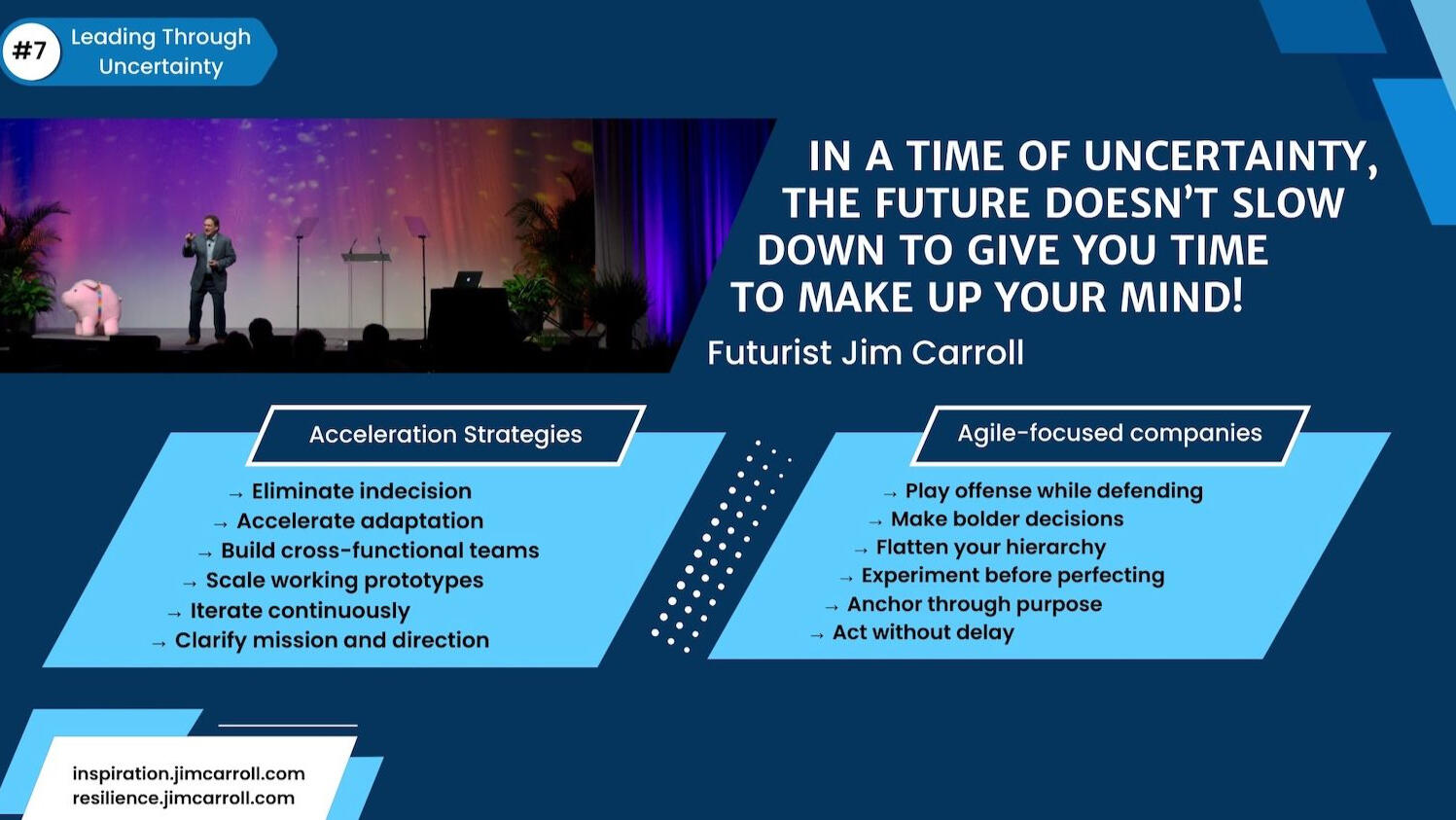
In every previous downturn, we’ve seen the same pattern. The companies that acted with agility—who streamlined decision-making, shortened timelines, and empowered their teams—came out ahead. They didn’t rush blindly. But they didn’t wait for permission, either. They were bold, fast, and focused. What did they do?
they built cross-functional teams with the authority to decide in real-time.
they prototyped quickly, then scaled what worked.
they adopted an iteration mindset: test, learn, refine—then repeat.
they aligned on mission clarity, so even in chaos, the direction was clear.
And that mindset isn’t just aspirational. It’s proven through research. I summed it up after the last crisis: “Bureaucracy is out. Speed is everything. The future belongs to those who can decide—and move.”Here’s the key thing to think about: agility isn’t recklessness. It’s responsiveness. It’s not about rushing blindly—it’s about having the confidence to move when others are still overanalyzing the map. The core idea that I’ve always shared in times of upheaval is action —that we must pivot, adapt, and accelerate. In today’s environment, fast beats big. The companies that win are those that can shift on a dime and execute decisively when conditions change.The greatest risk right now? It isn’t moving too fast. It’s moving too slowly while the world speeds up. And the greatest mistake? Doing nothing.So as this new era of global uncertainty accelerates, are you still fine-tuning your plans while others are executing theirs?Because the future isn’t waiting.And neither should you.
What the Smartest Companies Do in Uncertainty – Summaries from my ResearchPlay Offense While Managing DefenseResilient companies don’t just cut costs—they reinvest in growth while others hunker down. Agility means knowing when to shift gears, not hit the brakes.
Playing offense almost always trumps simply hunkering down. – Bain & Co.
Make Faster, Bolder DecisionsSpeed and decisiveness aren’t luxuries anymore—they’re necessities. Companies must enable decision-making at the edge, not wait for top-down approvals.
Faster decisions lead to better outcomes” – McKinsey
Empower Cross-Functional CollaborationEmpower Cross-Functional CollaborationAgile organizations flatten hierarchies and give decision rights to real-time teams. Structural agility creates momentum.e, not wait for top-down approvals.
Resilient leadership is about empowering others to act
Embrace Experimentation Over PerfectionThe best companies try, test, learn, and adapt—quickly. They think in prototypes, not polished plans.
Don’t wait for the perfect strategy. Build, measure, adapt.
Stay Anchored by PurposeMission clarity helps teams move fast without losing their way. In times of stress, purpose is the north star.
Core values stabilize culture when the world is unstable
Understand the High Cost of WaitingHarvard research shows up to 85% of pre-recession growth leaders are toppled during downturns—often due to indecision, not miscalculation.
Waiting too long weakens the company” – HBR
#8 - April 16, 2025
The future won’t wait for your zip code to catch up!
Yesterday I noted that the future won’t slow down to wait for you to make a decision.It also has little respect for those who try to avoid the reality that they are in a global economy.When you step back and look around the world, something becomes crystal clear: The future is not unfolding in one place. It’s emerging everywhere—in labs in Ireland, factories in Vietnam, logistics hubs in the UAE, AI startups in Seoul, and solar grids in Morocco.
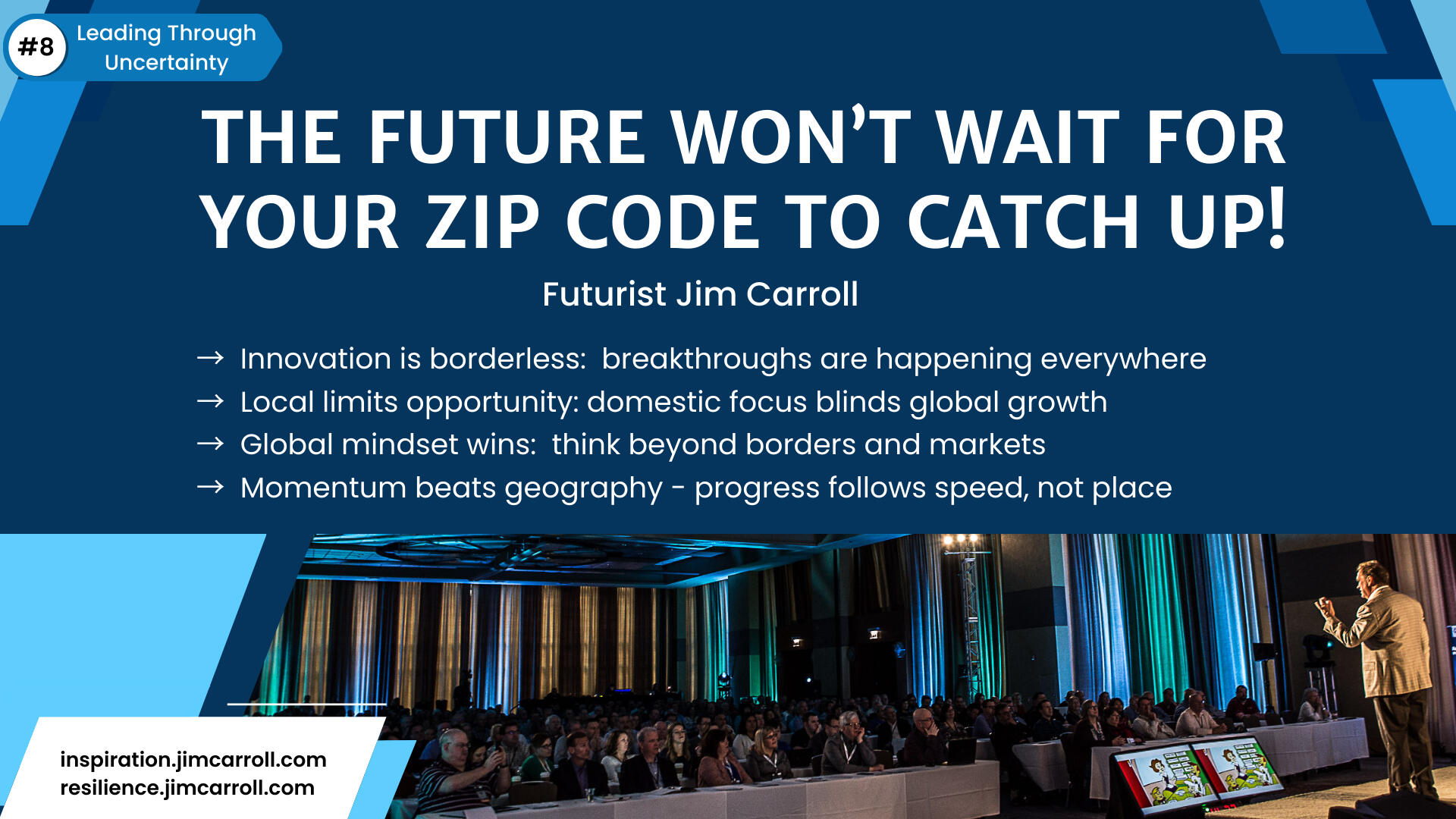
But while this global acceleration is happening, too many leaders and organizations are still thinking small. They’re stuck in a local mindset—tethered to domestic market opportunities, legacy business models, obsolete products or services, or outdated assumptions about where real progress comes from.Here’s the reality: you can’t lead in tomorrow’s economy by thinking inside yesterday’s borders. I’ve said it before – the future doesn’t care about your region, your history, or your comfort zone. It flows to where the momentum lives. And that momentum is increasingly global.
AI isn’t just a Silicon Valley story—it’s being industrialized in China, scaled in Europe, accelerated in the United Arab Emirates
the energy transition isn’t a North American trend —it’s becoming the default infrastructure in Scandinavia and the Middle East
electric vehicles aren’t some radical idea with a narrow future – it’s becoming the dominant platform in China, Finland, and elsewhere
advanced manufacturing isn’t stuck in Detroit—it’s transforming supply chains in Vietnam, Poland, and Mexico.
Meanwhile, companies that remain locally fixated are finding themselves cut off from opportunity—missing emerging markets, lagging on innovation, and getting blindsided by competitors they never saw coming. The world used to watch what happened in one or two countries to know where things were going. Now? You have to watch everywhere – because innovation doesn’t care about geography.This reality is accelerating in the current economic and political volatility that defies 2025 – such that while one region tries to restore past glories, the rest of the world has decided to continue moving forward. Watch the latter – not the former – to figure out where tomorrow is now unfolding.Here’s what that means for your strategy:
innovation is borderless. The most exciting breakthroughs are emerging everywhere regardless of where traditional power once resided.
local thinking limits opportunity. Organizations that remain focused only on domestic conditions risk missing faster, more dynamic growth in emerging markets.
a global mindset = competitive advantage. Future-ready leaders benchmark themselves against global competitors, track global trends, and build networks that cross borders and ecosystems.
the future flows to momentum, not geography. Progress doesn’t happen where it used to. It happens where the energy, talent, and ideas are moving fastest.
So ask yourself: Are you making decisions based on where the world once was? Or are you aligning with where it’s already going?Because the future isn’t local anymore.It’s global.And it’s moving fast.
#9 - April 17, 2025
In a downturn, you don’t find momentum. You make it!
In a time of volatility, uncertainty, and a lack of clarity, the most natural reaction is often the worst one: we do nothing.
We pause. We overthink. We wait for something to settle before we make a move.We seek clarity and wait.We end up waiting a long time – because the irony of this is that clarity doesn’t come from waiting—it comes from moving.That’s the real secret to getting through this volatile time.Over the past eight posts, we’ve explored what it takes to lead into the future when everything feels unstable: replacing fear with action, and nostalgia with vision. Challenging inertia through innovation, and stress through strategic resilience. Leading with agility over indecision, and thinking globally, not locally. Things like that.But none of that matters if momentum is missing. Because without motion and moving forward, there is no forward.
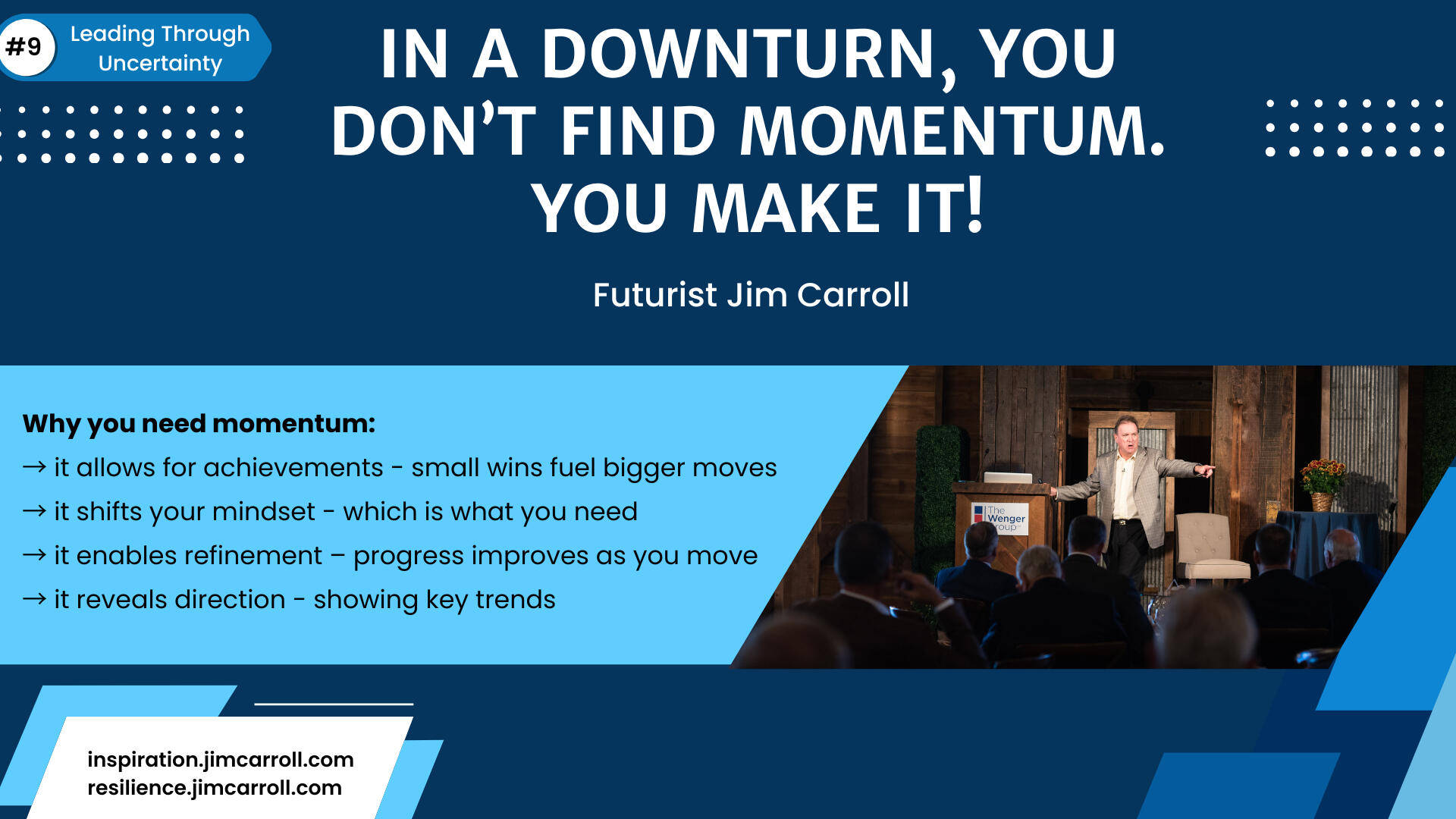
That’s why you need to imprint this idea in your mind. “You don’t find momentum. You make it.” The future doesn’t reward the ones who paused the longest. It rewards the ones who moved—even just a little—when no one else was.And here’s a secret you should know – progress isn’t always dramatic. Sometimes it’s quiet, compounding, and invisible to everyone except those who kept showing up. Let me be blunt – inaction is a decision. And it’s usually the wrong one. When volatility strikes, many leaders freeze – the exact wrong thing to do. But the organizations that keep moving build momentum that outlasts the downturn.Why do you need momentum, even if you don’t know where you are going?
It allows for achievements – small wins fuel bigger moves
It shifts your mindset – which is what you need
It enables refinement – progress improves as you move
It reveals direction – showing key trends
The key isn’t to make a massive leap. It’s to take the first step—and then another. And another. Soon you are walking into tomorrow – and then running. You are already well into the race to the future, while the rest haven’t even figured out where the starting line is.History is clear: those who paused missed the recovery. Those who waited for certainty were outpaced by those already adapting. Those who decided to wait for clarity ended up waiting too long for clarity that never came.And those who moved built the culture, rhythm, and resilience that carried them into the next chapter.Momentum wins. But only when paired with strategic intent.So ask yourself: What small move can you make today? Where can you lean into motion—even without full clarity?Because the future doesn’t arrive for those who waited.It accelerates toward those who refuse to stand still.
#10 - April 21, 2025
In the face of uncertainty, most managers cut. But leaders build.
Anyone can cut costs. Slash and burn. Downsize staff. Close divisions. And in an economic downturn, that becomes the norm.But there are only a few who can do the opposite - focus on growth.After nine days of exploring how to lead with resilience, innovation, and momentum, one truth now takes center stage:
Growth isn’t a result. It’s a decision.And in moments of deep uncertainty, the best leaders choose it - on purpose.
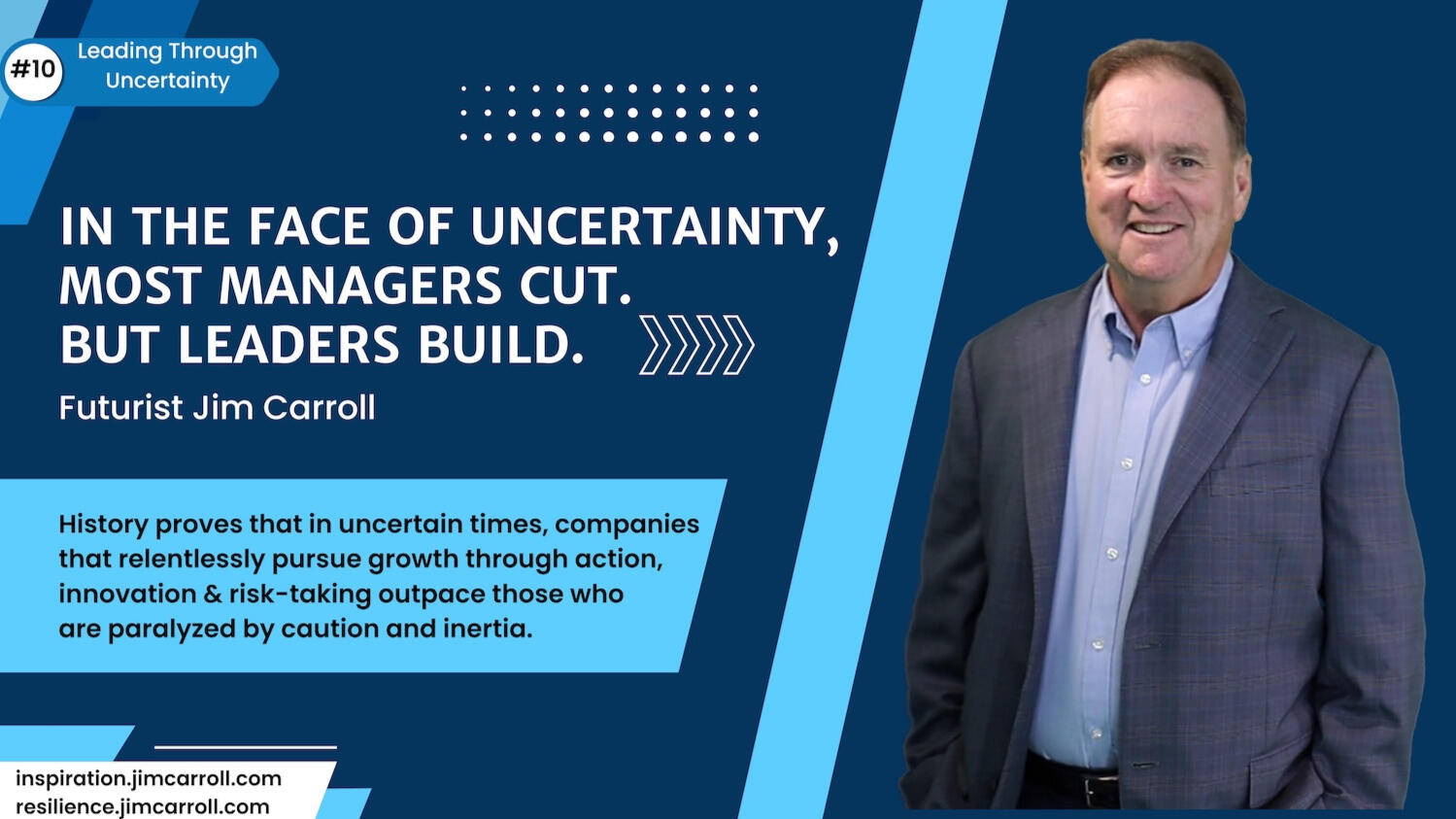
Back in 2009, I spoke at a lot of corporate events amid the global economic downturns and witnessed firsthand how different organizations were dealing with it. I vividly remember the message the CEO of one global organization delivered at their leadership summit, sharing their recession roadmap with perfect clarity: “Our strategic priorities: survive, innovate, grow. We’ve done survival. Now we’re focused on building.”That’s the growth mindset that is needed today. While others pull back, delay projects, freeze spending, and wait for signs of recovery, real leaders are moving forward. Fast. With intent. Because they understand that growth doesn’t happen after the storm passes. It begins now.Around that time, in an interview with FoodProcessing.com, I shared the story of a global restaurant chain CEO who spoke just after the 2008 financial crisis; I was to follow him on stage for my message on the importance of innovation and looking forward. He opened with one minute on the dismal economic conditions and then spent the next nineteen minutes outlining eight clear growth opportunities.He didn’t dwell on uncertainty. He obsessed over what came next.This is how bold leadership sounds.And in 2025, it’s exactly what’s needed. You might not see it, but this is what is happening in some organizations right now. And maybe it's the precise mindset that you need at this very moment. Right now, some leaders are:
investing with precision — not across-the-board cuts, but selective spending that seeds future wins
fueling innovation pipelines — not just keeping them open, but prioritizing breakthrough bets
rallying teams around possibility and opportunity, replacing fear with focus
proactively reshaping strategy to stay ahead of the curve, by building toward market shifts before they happen
taking initiative while others wait — knowing that momentum multiplies
They don’t just avoid decline—they architect their rebound.And you know what this leads to? A growth gap - a gap that is widening at this very moment. Some companies will emerge from this moment smaller, slower, and stuck. Others will come out faster, sharper, stronger—because they chose to act when it mattered most.The question isn't: “Will the economy recover?” It's: “Will you be ready when it does?” Or "Will someone else have already captured the ground you hesitated to take?”So ask yourself: Are you leading from fear? Or building toward growth?Because in the face of uncertainty, managers cut.But leaders?They build.
#11 - April 22, 2025
In a downturn, most companies don’t fail because they lack opportunity – they fail because they can’t get out of their own way.
Leaders build. Managers cut. That much is known. What is also known is that if you want to grow during a downturn, now is the time to move, not wait.But let’s be honest. You can’t build what’s next if you’re still stuck in what’s holding you back.That’s what this post is about.Before you get into a growth mindset in a downturn – which seems like a contradiction – you have to face the barriers that will hold you back. And here’s what I know from the advising leadership team during every major downturn since 2001: recessions don’t just expose economic volatility. They expose internal vulnerability.What are those vulnerabilities? Business models that no longer fit. Teams that are afraid to act. Cultures allergic to risk. Short-term thinking that kills long-term opportunity. Things like that.
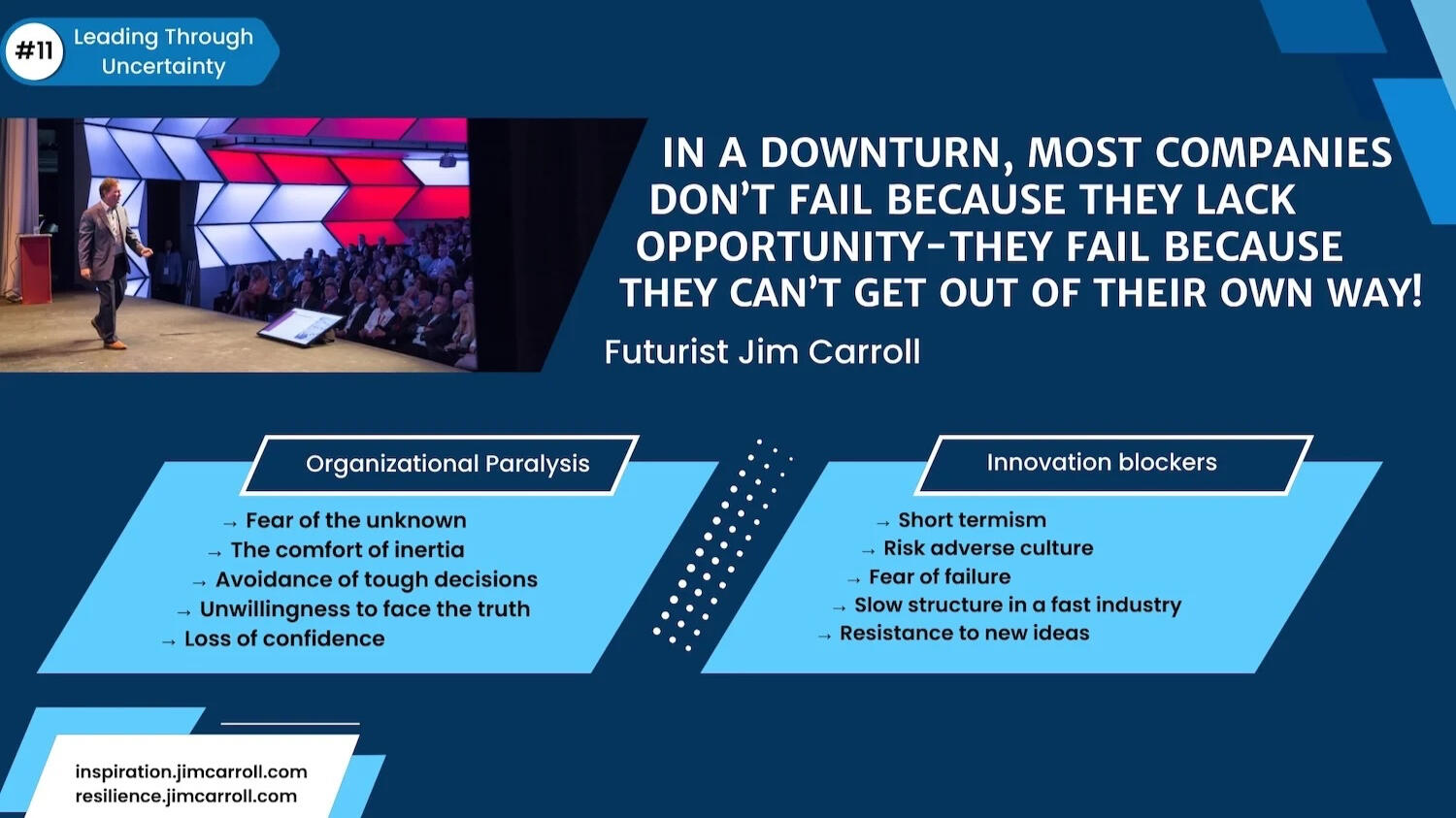
Over time, I’ve seen a clear pattern emerge in the way organizations respond to volatility – there are two kinds of companies:
those who got stuck in their economic rut, too paralyzed to move
and those who became fast, focused, and fearless innovation leaders
Both types were in the same economy – but only one type made it to the other side stronger.So what separates them? It’s not industry. Not funding. Not even market conditions. It’s this: the ability to confront what’s really holding them back. Because the reality is big disruption happens during big uncertainty, but most companies miss it, because they’re too focused on defending the past instead of designing the future.Back in the wake of the ’08 recession, I wrote a blog post that shared thoughts on ten reasons that are slowing companies down from succeeding during the downturn. It’s wildly relevant at this moment in time.First, there is organizational sclerosis, specifically emotional and structural forces that freeze progress. Let’s call it baggage. This includes:
fear of the unknown. Many leaders live in “what if” mode. What if the market doesn’t bounce back? What if customers don’t return? What if the top line doesn’t recover? The result? Paralysis. The entire organization freezes, afraid to move, afraid to decide, afraid to commit.
inertia is easy. Doing nothing becomes the default. Repeating pre-downturn behaviors feels familiar – but familiarity is not a growth strategy. Hoping yesterday’s habits will somehow carry you through a very different tomorrow is a dangerous illusion.
avoidance of tough decisions. Disruption brings hard choices – around talent, structure, priorities, and markets. But many teams would rather wait it out than make the call. They delay key actions, pretending things might go back to normal. Spoiler alert: they won’t.
unwillingness to confront the truth. A recession reveals all the cracks: outdated products, irrelevant brands, and underperforming teams. Good times hide mistakes. But now is the time for reality checks and action. Some leaders don’t want to look in the mirror. That’s a risk you can’t afford.
loss of confidence. Some leaders simply lose faith that they can adapt. They no longer trust their resilience. But confidence isn’t passive. It’s not something that magically returns. It’s built by moving forward, even when you don’t feel ready.
Then there are the mindsets that block future-focused thinking:
a short-term obsession. Many organizations are stuck in a three-month mindset. But opportunity lives on longer timelines. If you can’t think beyond next quarter, you’ll miss the five-year transformation already underway in your industry. The future belongs to those who think in strategic horizons: 1 month, 6 months, 1 year, 10 years.
risk-averse cultures. So far, you’ve survived by playing it safe. But caution isn’t enough anymore. The volatility has exposed your reluctance to try new things. Real growth now requires risk tolerance and a culture that supports experimentation, not perfection.
an ongoing and relentless fear of failure. In too many teams, failure is punished. Mistakes are whispered about. Innovation is avoided because the risk is unacceptable. But in a fast-moving world, failure is a teacher, not a threat. You need to try, test, learn, and try again.
a slow structure in a fast industry. Your product pipeline? It’s too slow. Your customer insight? Months out of date. Your internal approval process? Bureaucracy on autopilot. Fast markets require fast action. You need to move as quickly as your customers do, or risk losing them.
resistance to new methods and new ideas. Every industry has new ideas, new tools, and new processes. But are you embracing them? Or rejecting them because they’re unfamiliar? The global idea machine is running 24/7. Tune in. Rethink how you do things, from the ground up.
By letting these things hold you back during a downturn, you’ll never be ready for the upturn. Remember that key phrase from Bill Gates: “We always overestimate the change that will occur in the next two years and underestimate the change that will occur in the next ten.” While this period of economic uncertainty is ugly and will likely go on for some time, do you know where you could be ten years from now? What trends might be unfolding right now that could provide for massive future growth?Right now, that underestimation is your biggest risk – so before you plan for growth – clear the path.
You can’t implement a bold growth strategy on a foundation of fear, avoidance, or old habits. You have to unfreeze before you accelerate.So ask yourself:What’s holding you back right now?What decisions are you avoiding?What assumptions or habits are you still clinging to?Because before you can talk about growth strategy…before you can reimagine business models…before you can disrupt…you need to confront what’s holding you back.This isn’t about what’s happening around you.It’s about what’s happening inside your organization.
#12 - April 23, 2025
Growth doesn’t avoid chaos. It emerges from it.
You don’t rebuild for the future by protecting the past – particularly during a downturn.So let’s recap. In the first ten posts of this series, I’ve covered how belief, vision, action, and momentum create forward motion, even amid chaos. And yesterday, I pulled back the curtain on why many organizations fail to make that motion: fear, inertia, denial, and outdated thinking. You know, organizational sclerosis stuff!Now we turn a corner.Because once you’ve cleared the internal barriers…once you’ve named what’s been slowing you down… the next step is this: growth. And growth doesn’t come from optimizing what used to work. It comes from disrupting it. As they say, if you keep doing what you’ve always done, you’ll get what you’ve always got! This will become exacerbated even more in the wild year that is 2025.Fact is, In a downturn, many companies fall into a dangerous trap: they tweak the old playbook, hoping that what worked before will work again. So they shave budgets instead of rewriting business models. They cut costs without realigning purpose. They focus on “efficiency” instead of rethinking how they create value. They keep trying to sell the old product or service when the market suddenly needs a new one.That’s not a strategy. That’s maintenance. And it fails every time
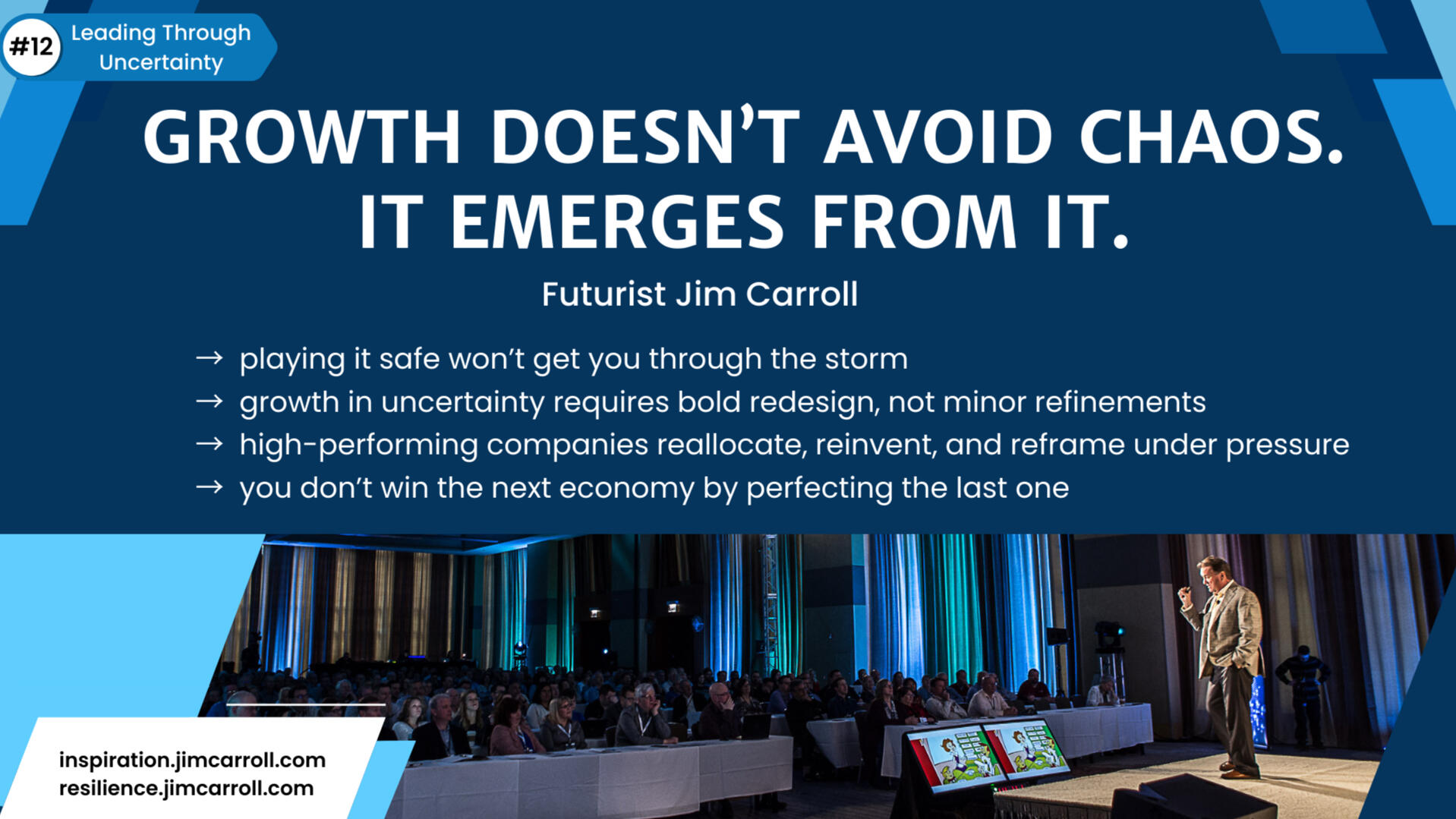
The companies that grow during volatility? They do the opposite. They redesign, not refine. They reinvent, not recover. They know that you won’t win in the next economy by trying to redo the last economy better. Here’s how high-performing, future-ready companies build through disruption—not despite it:
they create new value, not just cut costs
they launch new offerings that solve urgent problems in emerging markets or underserved segments.
they reallocate skills and teams aggressively to solve problems, fast
they implement a strategy of focusing on core customers to defend key revenue
Talent, capital, and attention all shift. They move decisively away from underperforming bets and double down on future-ready opportunities. They break their assumptions. They don’t ask how to make something slightly better. They ask what it would look like if they had to build it from scratch for today. They eliminate internal friction. Bureaucracy, bloated processes, and clunky systems are removed. They rebuild for speed and simplicity. They accelerate decisions with small, empowered teams that test, launch, and adapt.They don’t wait for perfect clarity—they create clarity through motion.If you want to grow through uncertainty, you need more than vision—you need action. Growth in a downturn doesn’t come from fine-tuning the past. It comes from designing for what’s next.The companies that do that don’t just recover. They redefine their markets.A Lesson from 2009: What Growth-Minded Companies DidBack in the wake of the 2008 economic collapse, I noticed a feature by BusinessWeek called 10 Worst Innovation Mistakes in a Recession, I believed the more important question was this: What should you do instead?So I wrote this post below in 2009, capturing real-world strategies I had seen in action across industries.Everything below still applies today—perhaps even more than it did then.10 Things You Need to Do to Innovate in a Recession
April 28, 2009Business Week ran an article in January, 10 Worst Innovation Mistakes in a Recession.It’s easy to point out mistakes. It can be harder to indicate what you should be doing.I’ve been speaking to organizations about trends, the future, innovation, and creativity for fifteen years. Since last year, when the meltdown began, I’ve been keynoting events worldwide, rapidly adjusting my theme to one of “how you can innovate during a recession.” I’ve had the opportunity to see firsthand quite a few very innovative strategies from CEOs and others in a wide variety of events, and I keep modifying my message at a rapid speed to incorporate a vast variety of ideas.So I just took a few minutes to post a comment to the Business Week site, and I’ll post my quick thoughts here too.Here’s a list of 10 off the top of my head:
Focus your team—relentlessly—on growth. I keynoted a global organization in Las Vegas in February. The CEO got on stage before me and spoke about the recession for one minute. He then spent 19 minutes outlining the growth opportunities the organization could pursue. That’s the mindset we need.
Respond faster. At a food industry summit in New York, we spoke about how consumer preferences were shifting rapidly—more people eating at home, watching spending, and seeking comfort. Reformulate products and launch fast. Don’t study. Do.
Invest in the brand. Brands can weaken in a recession. Now is the time to reposition or reinforce, not pause.
Mix it up. What worked before may not work now. Experiment with product mix, price points, and messaging.
Invest in experience. When staff are down and spinning their wheels, focus them. Build team resilience through experimentation and action.
Kill off the innovation killers. Paranoia kills creativity. Create a culture where “What a great idea” is the reflex, not “what could go wrong?”
Collaborate within the industry. I saw incredible peer-sharing during a keynote for the American Nursery and Landscape Association. Ideas were flying. Everyone benefited.
Seek ideas. Go knowledge farming. Great ideas for processes, products, or services are everywhere—go find them and apply them.
Partner up. Innovation accelerates with help. Partnerships in operations, technology, or delivery can bring growth faster than going alone.
Get over it. Too many teams stay stuck in grief over what was lost. Acceptance clears the path for forward motion.
Why does this advice from 2009 still matter in 2025? Because EVERYTHING on that list is still relevant. Still effective. Still ignored by too many.Growth in a downturn is not an accident. It’s a choice—and a commitment. The companies that succeed don’t overanalyze the chaos. They don’t cling to legacy plans.They act. They move. They build. They experiment. They disrupt.And because of that, they don’t just survive the storm.They shape what comes next.They grow.
#13 - April 24, 2025
Uncertainty? Don’t wait for clarity —create it!
In a downturn, experimentation isn’t risky. It’s responsible – because it helps to build some clarity where often that clarity does not yet exist.That doesn’t seem intuitive. In uncertain times, it’s easy to assume that clarity comes from caution – that the path forward will emerge once the noise dies down, once the data stabilizes, and once the market settles. You end up waiting a long time for that! You end up waiting for clarity that never comes, because here’s the truth: clarity doesn’t arrive. It’s earned.And the way you earn it—especially in a downturn—is by moving. Testing. Learning. Iterating. Acting. Trying ideas to see what works. Doing things for the sake of doing, not necessarily for the big win, but to figure out what works, and what does not. And in doing so, you create your sense of clarity. That’s how you cut through the fog. That’s how you avoid paralysis.That’s how you lead.
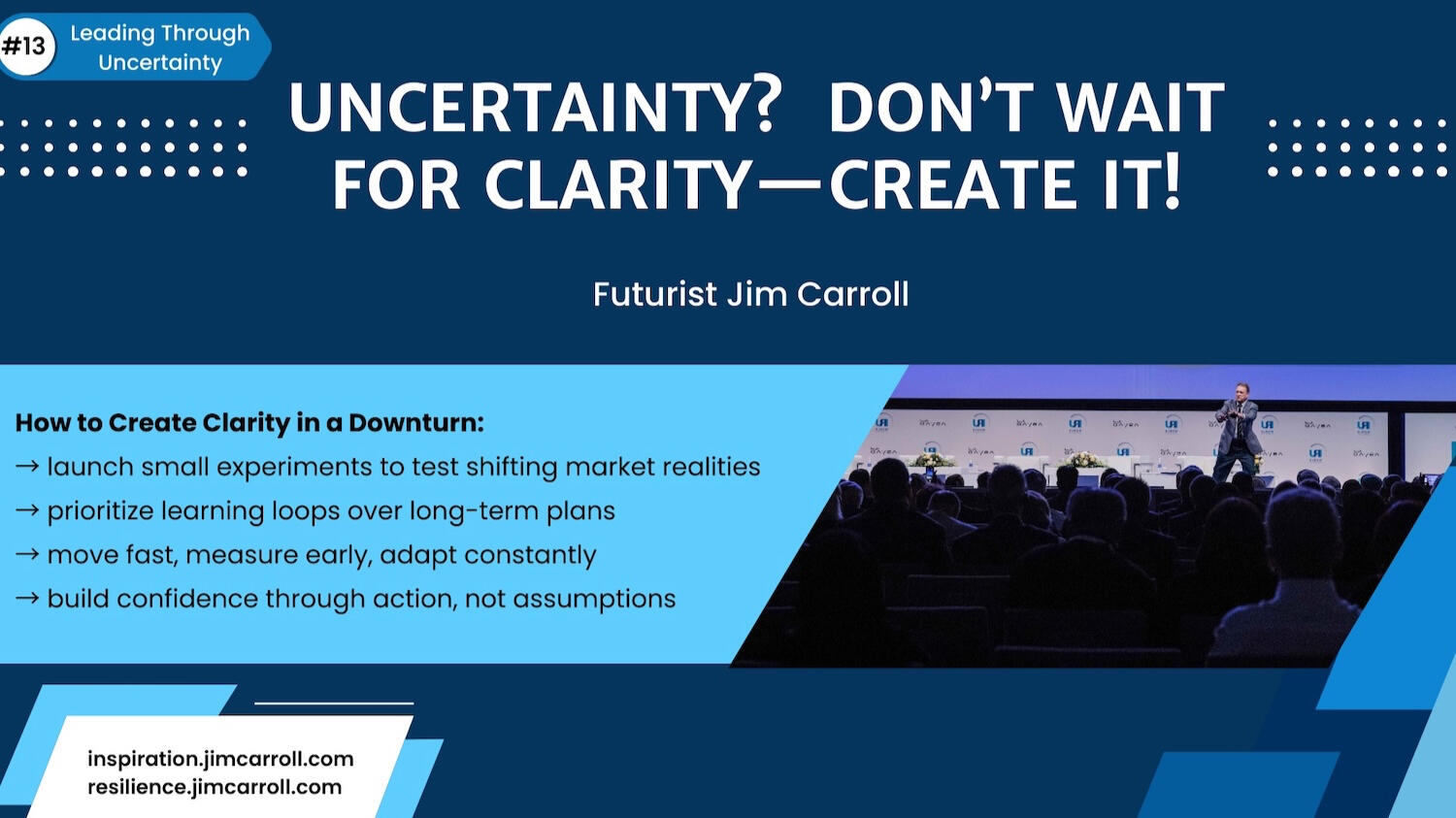
Experiments are your edge in an era of uncertainty because they are fuel to ignite clarity that is otherwise missing. Remember what I’ve said in this series – in times of economic pressure, many organizations retreat into stasis They pause product launches, cancel initiatives, and wait for signals. But the companies that thrive in a downturn do the opposite: They turn uncertainty into a laboratory. They run small tests. They build fast prototypes. They launch controlled rollouts. They create momentum—and clarity—through movement.That’s not reckless. It’s responsible. And it builds something more valuable than predictions or plans: experiential capital.Remember that? I keep pointing it out because it is one of the most important yet rarely recognized assets that you have, and it isn’t even on your balance sheet! It’s the practical insight and organizational confidence that only comes from doing. It’s what you gain every time you try something new, even if it doesn’t work. It’s what helps your team operate with speed and resilience when things are still volatile. It’s the single most valuable currency in a future defined by disruption. And it’s even more valuable in a time of uncertainty with a lack of clarity – because it gets you on the path to building your clarity. You build it by testing, launching, measuring, adapting—and trying again.Here’s the thing – history is full of examples of companies that chased ‘experiential capital’ through small projects and fast prototypes during previous periods of economic decline. The fact is, they prototyped their way out of crisis—and that’s what made all the difference.
Amazon: they launched AWS and expanded Kindle during two major downturns by testing small concepts that scaled with customer response. Today, both are billion-dollar pillars of their business.
Netflix: They tested early streaming in a cautious market. Iterated their platform and content model quietly until they were ready to lead. Streaming wasn’t a leap—it was a series of calculated trials.
LEGO: They turned near-bankruptcy in the downturn of 2001 to explosive growth by crowdsourcing new ideas, experimenting with themed kits, and embracing fast product testing.
Procter & Gamble: They ran micro-experiments during the ‘Great Recession’ of 2008 to adjust pricing, formats, and distribution. They didn’t pause marketing—they tested smarter ways to deliver value.
Adobe: They shifted from boxed software to SaaS (‘software as a service’) by prototyping Creative Cloud with a limited user base, tweaking based on feedback, and gradually scaling — all while the after-effects of the 2008 downturn were raging all around them.
Each of these companies succeeded not by waiting for clarity, but by creating it through action. Through short, sharp shocks of action. You need to do that, because as I’ve said before – the future doesn’t wait—and neither should you. In an economy where speed trumps certainty, your competitive advantage comes from what you’ve tried, not what you’ve talked about.Here’s how you start building that advantage now:
launch a live test. Choose one customer segment. Try something new. Measure real results.
prototype under pressure. Push a rough idea into the market. Let feedback shape the next version.
accelerate learning loops. Replace long planning cycles with fast experiments. Learn weekly, not quarterly.
capture insight. Build a shared learning bank. Don’t waste failure—mine it for gold.
empower your team to try. Make experimentation safe. Celebrate effort, not just outcomes.
rush something forward. It doesn’t have to be perfect—just real. Let motion build momentum.
track what works. Treat every test as a data generator. Use outcomes to refine, redirect, and repeat.
build a culture of motion. Innovation isn’t a project. It’s a mindset. You build it by doing.
Use urgency as fuel. In the face of hesitation, push forward. Action reveals what planning can’t. Make experiential capital your strategy. In a world that punishes delay, the most learned win.
small bets.
fast feedback.
clear learning.
scaled results.
You don’t get clarity by standing still. You create it through motion.Every prototype, every rollout, every bold test gives you a sharper lens on what works—and what comes next.
#14 - April 25, 2025
Speed beats hesitation. Especially when the path isn’t clear.
In a downturn, momentum matters more than perfection. Delay costs more than missteps. The biggest risk isn’t moving too fast—it’s moving too slow while the world speeds up.And yet, In times of uncertainty, the most natural instinct of all is to wait. Wait for the data. Wait for a signal. Wait until the noise settles, the picture clarifies, and the next steps feel obvious. But here’s what too many leaders forget – the path forward doesn’t get clearer by standing still, it gets clearer by moving.We are deep into a moment when the cost of indecision is far greater than the cost of action, and the trap of your ‘aggressive indecision‘ becomes more significant every day. I’ve seen it play out countless times: a moment of economic volatility hits, and leadership teams and people fall into a state in which they decide the easiest decision to make is to simply …. not make them.
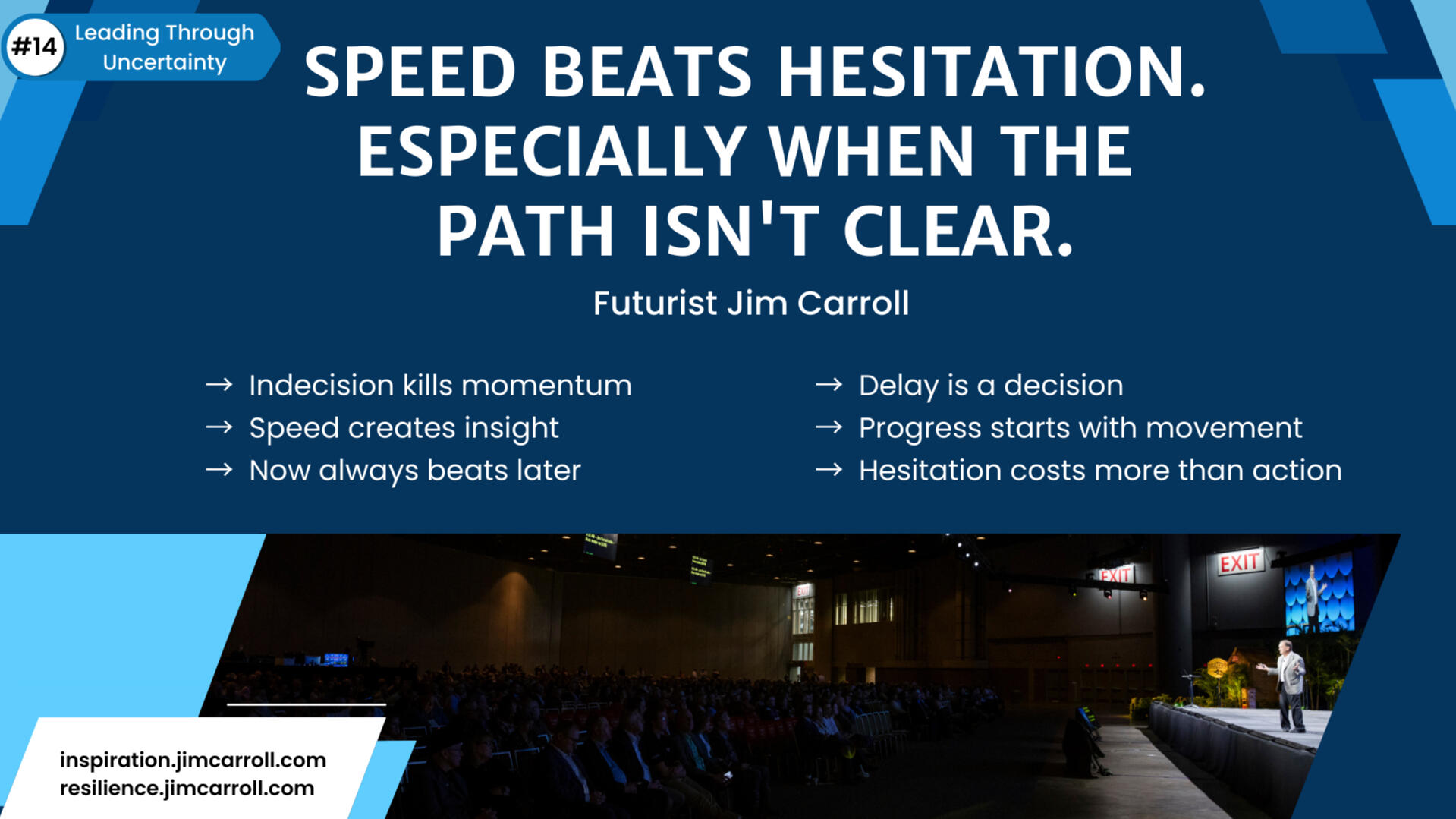
It’s not that they don’t care.It’s that they overthink things. They fritter away time in endless meetings. They chase every scenario. They wait for perfect timing. They pause strategic initiatives. They delay customer-facing launches.They stall their momentum—believing they’re being cautious when in reality, they’re just stuck. And so in a world in which the future belongs to those who are fast, they slow down.And while they stall? Markets shift. Competitors move Talent gets restless. Customers look elsewhere. That’s the wrong thing to do – history favors the decisive, and who move at the speed demanded by fast-changing circumstances.Data backs this up. A comprehensive Harvard Business Review study of 4,700 public companies over three recessions found that the top performers weren’t the ones who paused—they were the ones who acted strategically, quickly, and with confidence. Only 9% of companies outperformed their peers after a downturn—and they did it by balancing discipline with decisive moves at speed. A McKinsey study found the same: companies that moved first and fast during a downturn consistently gained market share during the recovery.Those aren’t isolated studies. Decades of research from leading economists, consulting firms, and central banks make one thing clear: waiting because of indecision is expensive. Academic studies have shown that uncertainty during past downturns, like the 2008 financial crisis, accounted for as much as 30% of the decline in corporate investment. The broader economic impact is real – GDP drops, market share is lost, hiring slows, and indecision cascades through entire industries.In short? While caution may feel responsible, the real risk lies in hesitation. Doing nothing often costs far more than doing something imperfectly. Moving slowly to ‘wait and see’ is doomed to fail when things are moving too fast. If you’re waiting for perfect conditions, you’ll be waiting forever! If you’re waiting for 100% certainty, you’ve already lost your window.So what should you do? Refuse to follow the instinctual response of slowing down. Make some small moves that break the freeze. Recommit to one stalled project and push it forward—this week. Create a 30-day “action sprint” around a market opportunity. Empower your teams to act on ideas without needing executive sign-off. Turn a strategy deck into a working prototype.Start moving. Fast. Start moving before you’re ready – simply because you know that speed matters.
#15 - April 28, 2025
Leaders who think beyond the current storm are the ones who shape what happens after it.
Here’s a key thing to think about: strategic foresight always beats tactical firefighting.The strongest organizations think beyond today’s chaos—and start building the world they want to lead. That’s because they know that economic growth always follows the minds that create the ideas of tomorrow, and they know it’s better to be one of those minds.Most leaders and organizations don’t do this though. It’s easy, in a time of volatility, to fall into survival mode. Watching the headlines, managing today’s problems, and delaying everything else. But if history teaches us anything, it’s this: the companies that think beyond the current storm are the ones that shape what happens after it.They don’t just react to the present—they create the future. They subscribe to the most important statement about the future made by Bill Gates: “Most people tend to overestimate the rate of change on a two-year basis, but underestimate change on a ten-year basis.” With that in mind, they know one of the most important things they need to be doing right now is to ensure they have a firm grasp of what comes tomorrow – and what they need to do about it.
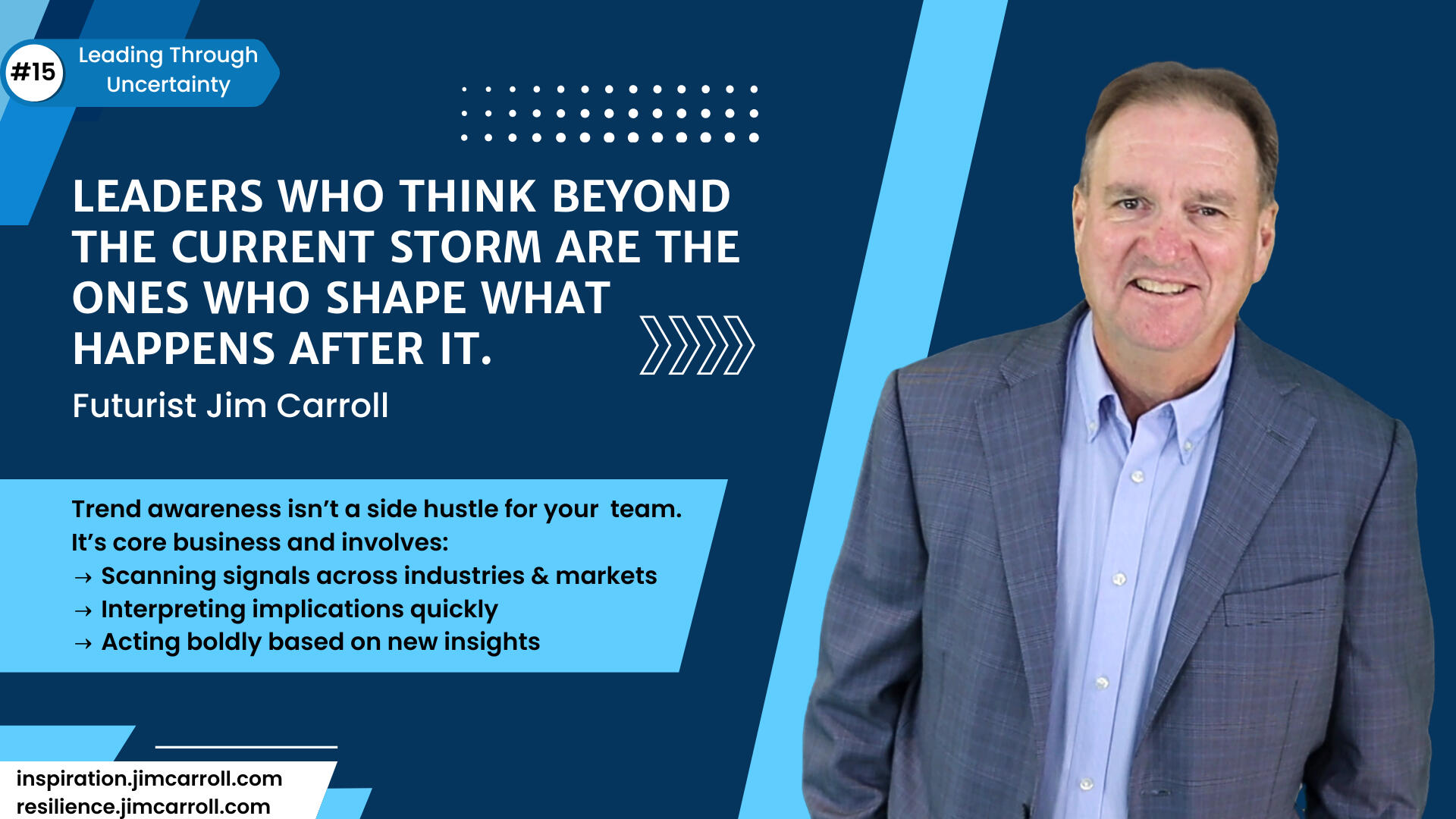
Here’s a key thing to think about: strategic foresight always beats tactical firefighting.The strongest organizations think beyond today’s chaos—and start building the world they want to lead. That’s because they know that economic growth always follows the minds that create the ideas of tomorrow, and they know it’s better to be one of those minds.Most leaders and organizations don’t do this though. It’s easy, in a time of volatility, to fall into survival mode. Watching the headlines, managing today’s problems, and delaying everything else. But if history teaches us anything, it’s this: the companies that think beyond the current storm are the ones that shape what happens after it.They don’t just react to the present—they create the future. They subscribe to the most important statement about the future made by Bill Gates: “Most people tend to overestimate the rate of change on a two-year basis, but underestimate change on a ten-year basis.” With that in mind, they know one of the most important things they need to be doing right now is to ensure they have a firm grasp of what comes tomorrow – and what they need to do about it.Why does it matter? Leadership during uncertainty isn’t just about managing immediate fires. It’s about constantly asking: “What world will emerge next—and how do we lead it?” Forward-oriented thinking forces you to operate across two horizons: managing today’s pressures realistically, and strategizing tomorrow’s opportunities relentlessly. You can’t do the latter if you don’t have a firm grasp on what comes tomorrow.McKinsey research shows that companies that allocate resources based on future trends—not just past results—outperform their industry peers by nearly 40% over 10 years. The fact is, short-term thinking Is a trap but sadly, it has become the norm. When volatility rises, leadership conversations shrink – from multi-year strategy to monthly budgets;
from future innovation to weekly crisis meetings; from new market creation to operational firefighting; and from big, bold, long-term visions to small, narrow daily actions.And the fact is, the longer you stay trapped today, the further you fall behind the leaders building tomorrow. The future doesn’t slow down in a recession – it speeds up.The future’s coming at us faster than ever before when uncertainty rages. Markets shift overnight. Customer expectations change in a heartbeat. Entire industries end up being reinvented while others quietly fade into history. You can’t afford to wait until the smoke clears. You’ve got to study what’s coming—and more importantly, act on it.That reality doesn’t go away in a downturn. This means keeping these realities in mind:
Leadership sets the tone. If you’re in any position of leadership, your job is crystal clear. You need to establish a culture that’s focused on the future. You’ve got to constantly connect today’s actions to tomorrow’s realities. If you’re not encouraging your team to move faster, think bigger, and adapt quicker, you’re holding them back. In a downturn, this means getting them out of their short-term funk into a longer-term mindset.
Watching isn’t enough. A lot of people think that reading a few reports or attending a conference checks the box. It doesn’t. Observing trends is passive. Real leadership demands that you take those observations and turn them into actionable plans. Trend-watching without action is just glorified procrastination. Double down on that right now despite a lack of clarity.
Innovation is the engine, but trends are the fuel. When I talk about studying the future, I’m always talking about innovation. The best innovators aren’t just reacting to change. They’re anticipating it. They’re building for it. They’re using it as fuel. Innovation isn’t some big mysterious thing. It’s simply the act of responding intelligently and creatively to the trends shaping your world. And if the trends shaping your world are doing so in an uncertain way, you’ve gotta be prepared to fire up your creativity engine, in a way you might not have had before, because you now have to imagine what was once unimaginable.
It’s not just about dodging disruption. Yes, the future brings threats. But it also brings opportunities—huge ones. The organizations and people who thrive are the ones who don’t just try to defend against what’s coming. They lean into it. They find the openings others are too scared or too slow to see. And here’s a fun fact – disruption doesn’t disappear in a downturn. History is full of examples of companies that took advantage of the uncertainty to launch their bold idea, knowing that everyone was too busy panicking to watch what they were doing.
The future isn’t a project – it’s a way of life. Studying future trends isn’t a “one-and-done” effort. You don’t build a strategy and walk away. You build a mindset. A daily habit. An organizational muscle that stays tuned to change, every single day. And that should not go away during a time of uncertainty.
Here’s the real takeaway: studying the future isn’t about predicting what’s going to happen. It’s about building the capability to respond faster, smarter, and more aggressively than everyone else. It’s about seeing what’s next before it hits and being ready when it does.You can’t sit back and hope the future will be kind to you. You have to go out and shape it.The companies that will dominate the next decade are already investing in new capabilities, technologies, markets, and ideas—even while today’s challenges are raging. That’s why I always suggest that a recession or downturn is the best time for an organization to align to my Trends & Innovation Loop – something I outlined way back in 2007 as I saw the economic storm clouds gathering for what would become the great economic meltdown of 2008.
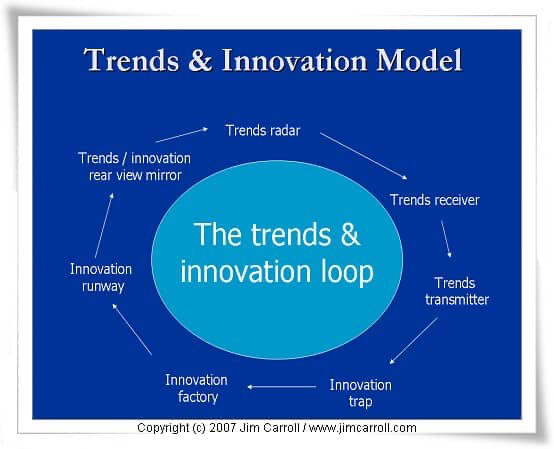
The process works like this:
Scan emerging trends relentlessly – technology, customer behaviour, science, business models
Anticipate disruptive shifts early. – spot cracks and emerging opportunities before they go mainstream
Innovate intentionally – build offerings and strategies for the world that is coming, not the world that was.
Accelerate learning and execution – prototype, refine, and scale based on what works.
Repeat continuously – trend-watching and innovation aren’t one-time projects – they are permanent leadership disciplines.
Trend awareness Is a key leadership discipline that becomes more important in a time of uncertainty – and future-ready leadership demands building “trend radars” directly into the organization. That means formal mechanisms for scanning signals across industries and markets, interpreting the implications quickly, and acting boldly based on those insights. As I always like to say – trend awareness isn’t a side hustle for your innovation team. It’s core business. In today’s economy, ignoring trends isn’t just risky – it’s fatal.So what do you do? Make sure you have your team studying the things that matter. Build discussion of the future into every strategy meeting, even when you are firefighting. To define your actions, start with tomorrow’s opportunity, and work backward. Anchor every short-term move against a long-term goal: Don’t act without some sort of future context. You might even consider implementing a dual operating mode: One team manages current crises. Another explores emerging possibilities.Realize this: tomorrow’s winners are already thinking past today’s chaos.Join them – because the leaders and companies who thrive will be those already inventing tomorrow through trend vigilance that drives bold innovation.
#16 - April 29, 2025
In a time of uncertainty, fear is cheap. Hope is powerful.
Throughout my career, I’ve often made fun of many motivational speakers.I certainly see a lot of them – they are often on the agenda with me at the conferences and events at which I speak. And look, there are some really good ones – they could motivate you to run across the Sahara in a bathing suit while eating broccoli. At the same time, many just have a bit of a schtick. I find they are a little bit like Chinese food – you are wildly surprised and super-motivated for an hour and then kind of forget about it. And besides, I don’t think walking on fire bricks can make you a better person.With that bit of cynicism out of the way – and I’m sure they can lob lots right back at us futurists – I will admit that I have billed myself for a time as a “motivational futurist.” That’s not a stretch – after all, my job is not just to help people understand the trends that define tomorrow, but to give them some motivation as to what to do to get there.That type of thing is also the role of anyone in any type of leadership position – your job is to motivate people to align with what comes next. The simple facts behind this reality are simple. Leaders lead. They set the tone. They establish the vision. They guide the path forward. They motivate their team. They inspire them to do what’s necessary. Leadership is all about lifting people up, and not letting fear drag them down

And all of this becomes ten times more important during a time of volatility, chaos, and uncertainty. Why? In a downturn, people lose sight of the future because of fear and uncertainty. The lack of clarity and the relentless pounding of news headlines and social media posts means that fear is accentuated.Think about it: everyone on the team is worried, cautious, and seeking clarity—at a time when clarity is in short supply. They’re confused, stressed, and looking for signs of guidance. Without it, they spin their wheels. In times of uncertainty, this becomes a deadly mix:
fear spreads faster than facts.
caution hardens into paralysis.
people stop moving toward opportunity—and start freezing around problems.
without strong leadership, a team’s mindset collapses inward.
the survival instinct takes over.
momentum evaporates.
That’s why, in a downturn, the most important role of a leader in this circumstance is to fill in the gaps – the gaps in confidence, courage, clarity, and commitment. They need to keep everyone relentlessly focused on the future, not yesterday. This becomes even more critical during an economic downturn because the margin for error shrinks and the potential for derailment grows.So what does motivational leadership look like in a downturn? It takes on this role:
Setting a clear, future-focused vision. Even if the path is winding, the direction must be steady.
Staying visible, optimistic, and human. Teams don’t need superheroes—they need leaders who show up and care. Empathy matters more than ever before, even if there is some brutal cost-cutting underway
Spotlighting progress—no matter how small. Small wins are the antidote to fear. Progress creates oxygen.
Protecting core purpose and values. Even if tactics shift, the mission remains.
Focusing attention forward. Every day, leaders must reframe the narrative: “We’re not stuck. We’re building.”
What happens if this type of empathetic and clear leadership is in place? Momentum starts with a firm belief about the potential for tomorrow. A motivated team moves faster, experiments more, recovers quicker, takes on bigger innovation risks, and overall, wins bigger. In the absence of that belief, even the best strategies collapse, but in the presence of belief, even imperfect strategies get traction.Bottom line? Volatility doesn’t kill companies. Fear does. Motivational leadership is the cure.In every downturn, the leaders who keep their teams inspired, energized, and looking forward are the ones who emerge stronger—and bring everyone with them.
#17 - April 30, 2025
In an uncertain economy, resilience isn’t built alone. It’s built together.
I’ve long shared this quote on stage: “If I have an idea and you have an idea, we have two ideas. If we share those ideas, we have a movement.”That’s the power of collaboration – something that is one of the most important hidden assets of any organization.And, you know what I am going to say – in an economic downturn, this becomes more important than ever before. It becomes a battle of collaboration vs. isolation, with a simple reality that while crises make teams turn inward, their outward connection creates resilience. Organizations that build stronger networks during downturns emerge stronger, faster, and future-ready.Why is that? Ideas are currency, fuel for recovery, and the more ideas flow, the more collaborative thinking flows. That’s why in volatility, connection beats isolation. And yet, economic volatility often triggers a dangerous instinct: retreat. Organizations turn inward, teams break into silos, and collaboration shrinks – and as a result, creativity suffocates and the idea factory slows down or worse, stops.But if history has shown us anything, it’s this: organizations that lean outward—toward partnerships, extended idea ecosystems, and shared ideas—are the ones that not only survive uncertainty but surge ahead when recovery comes.The fact is that isolation fractures resilience. Collaboration builds it. So the most important thing you can be doing right now is to build your collaborative spirit.
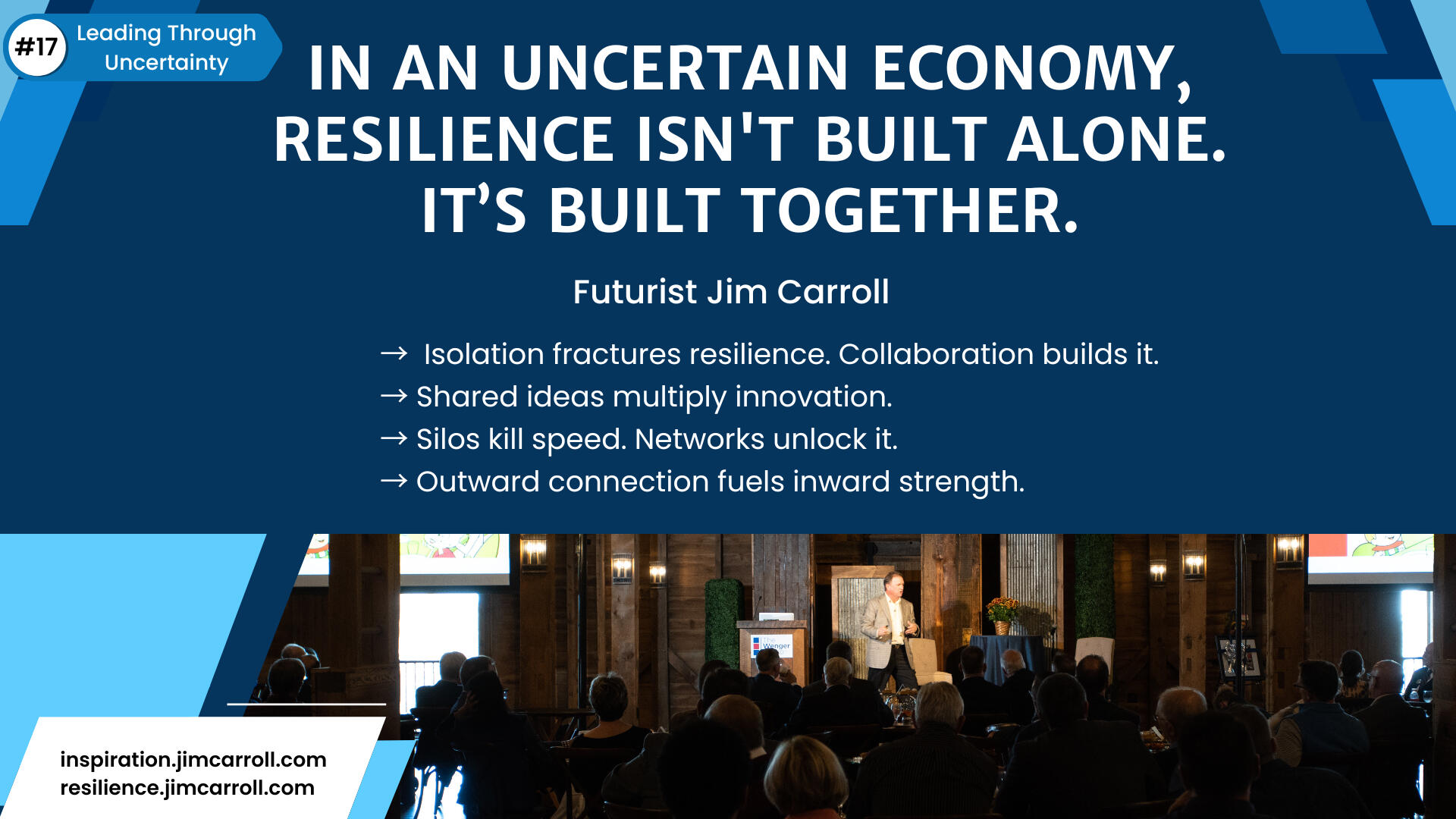
Here’s what resilient, forward-looking organizations do during periods of uncertainty. They:
break silos: They shatter internal barriers with radical transparency and cross-functional teams.
forge partnerships: They build new alliances and ecosystems to solve shared problems faster.
leverage external ideas: They tap into crowdsourcing, open innovation, and “knowledge farming” for fresh insights.
establish cross-industry boundaries: They encourage collaboration not just within their industry, but across disciplines.
prioritize shared success: They foster a mindset where growth is collective—not just internal survival.
They build bridges when everyone else builds walls, knowing that it’s critical to keep their idea machine running. Quite simply, shared ideas power future growth. Innovation doesn’t happen in isolation. It happens at the intersections of shared thought. I’ve shared this idea from the sage many times – world-class innovators understand:
innovative organizations have cultures where ideas flow freely across teams and silos.
the “infinite idea loop” which I mentioned yesterday – a global flood of new knowledge, insights, and thinking – is always running, and smart companies are always tapping into it.
future growth will come from those who plug into this global innovation machine—not from those who try to invent everything themselves.
the source of great ideas is shifting outward: open innovation, crowdsourcing, partnerships, and community networks.
companies that rely only on internal R&D fall behind, while those who collaborate across boundaries leap ahead.
collaboration with the edges is critical, as innovation increasingly occurs at the fringes, in spaces between industries, through unexpected partnerships.
it’s not just the edges but collaboration with other organizations matters – organizations must embrace external creativity—and recognize they can’t master everything internally.
There’s no reason all this has to stop because of economic challenges! Building a collaborative culture internally, where every team member shares insight, is a critical asset. In a downturn, it’s a necessity, because it’s important to start focusing on what comes next. Building on that collaboration – the sharing of community knowledge – will keep everyone ahead of trends—and fuel the collective innovation necessary to get to tomorrow.The simple fact is that innovation thrives when ideas are shared, combined, and multiplied—not hoarded. Isolation Is a risk. Collaboration Is a competitive edge.And in every major downturn, the companies that isolated themselves struggled to adapt as they came out the other side.The companies that built networks, forged partnerships, and tapped into the idea economy?They came out faster, stronger, and smarter.When fear makes others shrink inward—lean outward.Because in today’s economy, resilience isn’t built alone.It’s built together.
#18 - May 1, 2025
Remember that the teams you grow in uncertainty are the ones that lead you in recovery.
Start building the team you’ll need tomorrow – today.That’s always been a priority for any organization, but it’s probably even more important right now.That’s because most companies consider downsizing as the first instinctive reaction in a downturn. That’s often the wrong thing to do because they will find themselves in a precarious position as they come out the other side. Don’t just protect your team. Prepare it. Don’t just retain your talent. Grow it!The fact is, teams who lead tomorrow are being built right now.
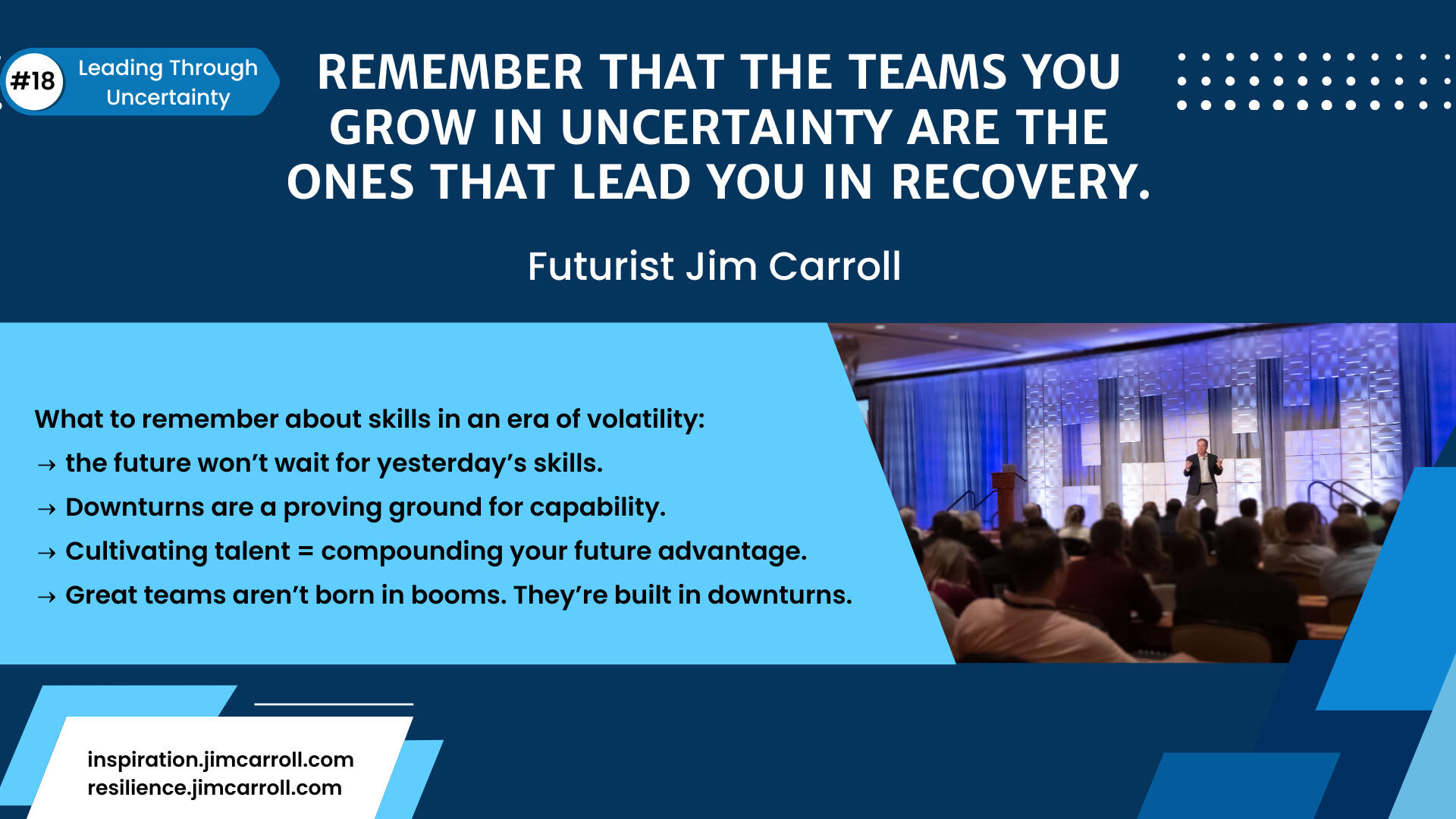
Downturns are when truly great teams are built, not just maintained. Organizations that invest in people during volatility create their future competitive edge, because when the recovery hits – and it always does – the prepared teams move first. So start today. Launch the training. Run the stretch assignment which will challenge your team to do the extraordinary. Bet on someone’s potential. Fuel your people with purpose. Because the future won’t wait for you to catch up.Why is this critical? Because we’ve entered a new talent era in which skills access is one of your most important success factors. That’s a reality, downturn or no downturn. Here’s why:
knowledge is fragmenting. Careers are splintering into hyper-specialized niches.
skills are degrading. The half-life of knowledge is collapsing
talent is transient. Loyalty is low. Agility is everything.
complexity is rising. You need the right skills—on demand, not just on payroll.
experience is the edge. Teams that learn through doing adapt faster.
All of this means that you’ll never have all the knowledge you need to get things done, downturn or not. You are in a constant war for the best talent, a perpetual race for skills. That war doesn’t stop when the battlefield of a downturn begins. When others hit the “pause“, successful organizations know that when things improve, having the right talent and teams in place will let them fly. So what do they do? Rather than cutting, they invest by pressing the “play” button:
doubling down on learning – targeting the skills they’ll need next.
expanding internal opportunities through mobility – giving stretch assignments and growth tracks.
investing in experience – running fast-cycle innovation sprints to build skills through action.
building trend-aligned capability – aligning training with what’s next, not what’s safe.
In doing this, they build a powerful currency – loyalty. All around them, their people see people see people being downsized and let go, while they remain stable. That matters – it’s showing people they matter especially when times are tough.Trust me, their loyalty will matter as conditions improveYour next competitive advantage isn’t a product.It’s a smarter, faster, future-ready team.Because success in a high-velocity economy comes down to one thing: the people who are ready for it.
#19 - May 2, 2025
Don’t focus on keeping your business alive. Focus on keeping your customers inspired.
In a downturn, you need to be customer-focused, not company-centered.Crisis pulls you inward, but growth demands you look outward. And in a downturn, obsessing over evolving customer needs is how you find your next growth curve.Look, when uncertainty strikes, it’s natural to look inward. Protect what you have. Defend your position. Hunker down and wait it out. But growth doesn’t come from within. It comes from listening to the people you serve – your customers. In every downturn, the companies that come out stronger are those that never lose sight of one thing: customer behavior is changing faster than your business model.
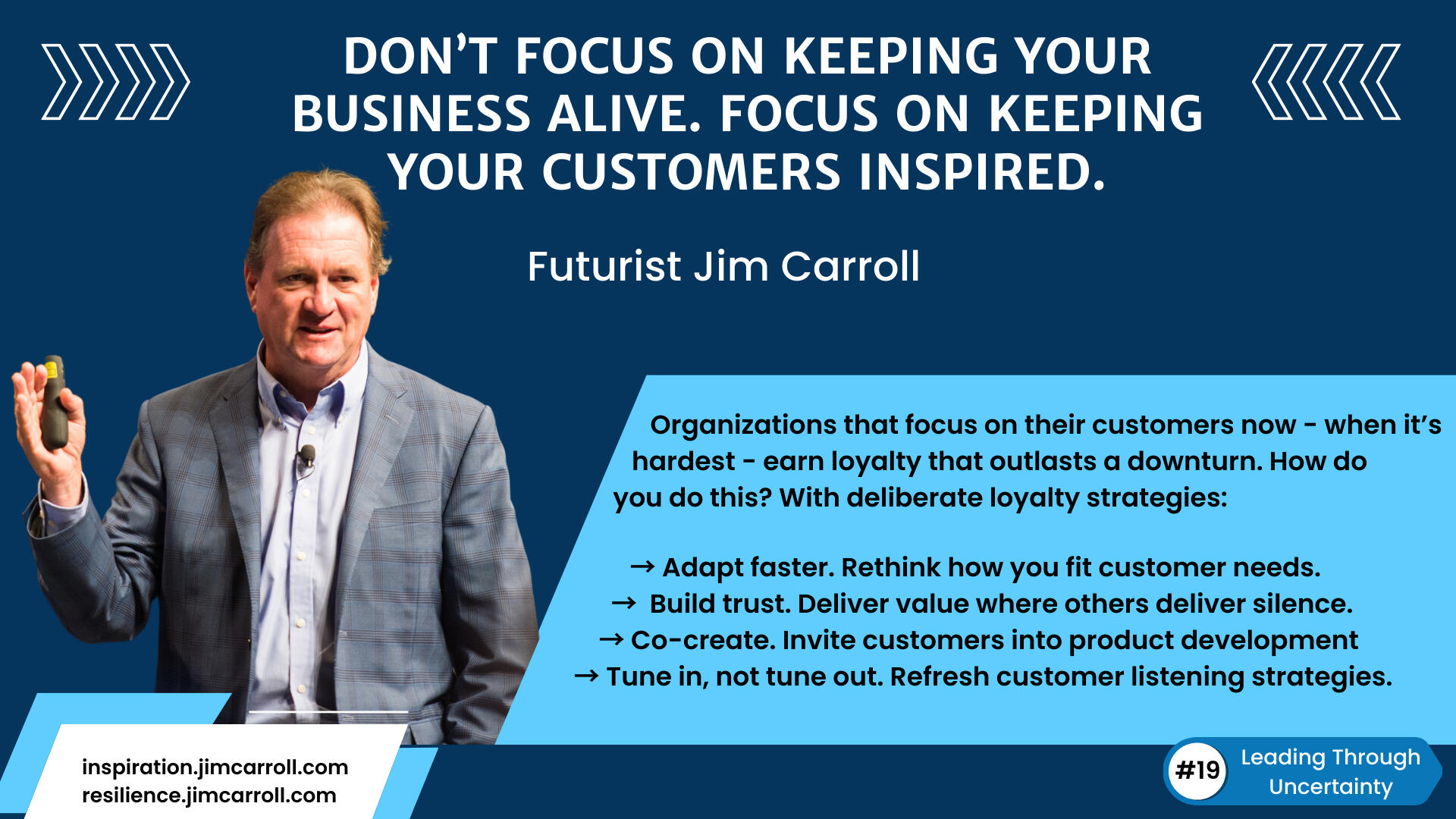
Economic volatility reshapes priorities:
how customers spend
what they value
what they trust
what they expect next
And in that shifting landscape lies your greatest opportunity—if you’re paying attention.I have two memorable customer moments in the immediate aftermath of the ‘Great Recession‘ of 2008. The first occurred when I spoke at a leadership event for the Compass Food Group. The CEO spoke about the downturn for just a few minutes – and then explained in detail how their strategy for the next many months was to be obsessively customer-focused. Talking to them, understanding their unique needs, how things were changing, and what the organization could do to serve them better. “We’re going to focus on helping them get through this thing and that will get us through this thing” was his core message.The second was at an event for the Readers Digest Food & Entertainment group in New York City – I had a room full of senior executives for food, consumer products, packaging, advertising, and other companies. After my my keynote, during the Q&A, one individual told the room that their business was stock photography as used in advertisements – and she commented that she was planning to upstate New York to take a bunch of photos of rural America, Why? Because she perceived that advertising messages focused on warmth and comfort would come to dominate – and she wanted to have material that would support that sort of message. Fun fact – she was right. After the recession, it was shown that Campbell Soup was one organization that saw significant revenue growth, because more people were cooking at home, and saw the brand as something that provided …, as seen in its advertisements … comfort and warmth.The thing is – your customers were already changing before this moment, but now it accelerating. Customer behavior was undergoing a massive transformation:
customers became less loyal and far more demanding.
they expected instant support, frictionless service, and constant innovation.
loyalty eroded fast—1 in 3 highly loyal customers in 2007 switched brands in 2008.st
they’re more informed—often knowing more than your frontline staff.
they expect your brand to match the pace of a global innovation feedback loop.
their attention spans are short, buying behavior erratic, and brand expectations sky-high.
peer networks and reviews now outweigh traditional marketing as purchase drivers.
demographics are shifting—Gen Z and Gen Alpha expect personalization, ethics, and purpose.
values are evolving fast: transparency, sustainability, authenticity, and speed now define success.
The fact is, we now live in a time in which we have to build new relationships with customers because everything about the customer relationship has changed. Customers today can instantly go public on social networks with feedback and commentary on interactions with a company – and it’s not always complimentary. They can instantly price compare through their mobile phones, rendering almost obsolete the concept of customer loyalty. They can band together in new and unique ways and ‘swarm shop’ through last-minute deal services, which can substantially cut into profit margins. And they can even render a brand-new product instantly obsolete if it doesn’t match their expectations.In this landscape, customer expectations don’t slow down during a downturn—they sharpen. That’s because they are supersensitive to everything – price, quality, level of service. Their expectations of you go through the roof because it’s their hard-earned money, and they want the best they can get!In a downturn, companies don’t just survive because they “stay the course.” They redefine the course based on where the customer is headed. This means that right now, you need to be obsessively customer-focused., It’s a moment to:
tune in, not tune out. Refresh your customer listening strategies.
adapt faster. Rethink what you offer and how it fits current needs.
co-create. Invite customers into the product development and feedback loop.
build trust. Deliver value where others deliver silence.
The organizations that center their customers now—when it’s hardest—earn loyalty that outlasts the downturn.Because the best growth strategy in any economy is simple: Don’t focus on keeping your business alive.Focus on keeping your customers inspired.Your revenue will thank you for it.
#20 - May 5, 2025
A downturn reveals who was merely surviving and who was preparing to thrive
What happens when you don’t do the things you should be doing when times are good? Those things you didn’t do stick out like a sore thumb when times are bad!Let’s be blunt: recessions expose the cracks that were already there. And if we’ve spent the last 19 posts building a blueprint for resilience, innovation, momentum, and opportunity — it’s time to talk about the other side of the coin. How recessions make things go wrong, fast, for those who haven’t done a great job of aligning to a changing world.Because not everyone makes it through.
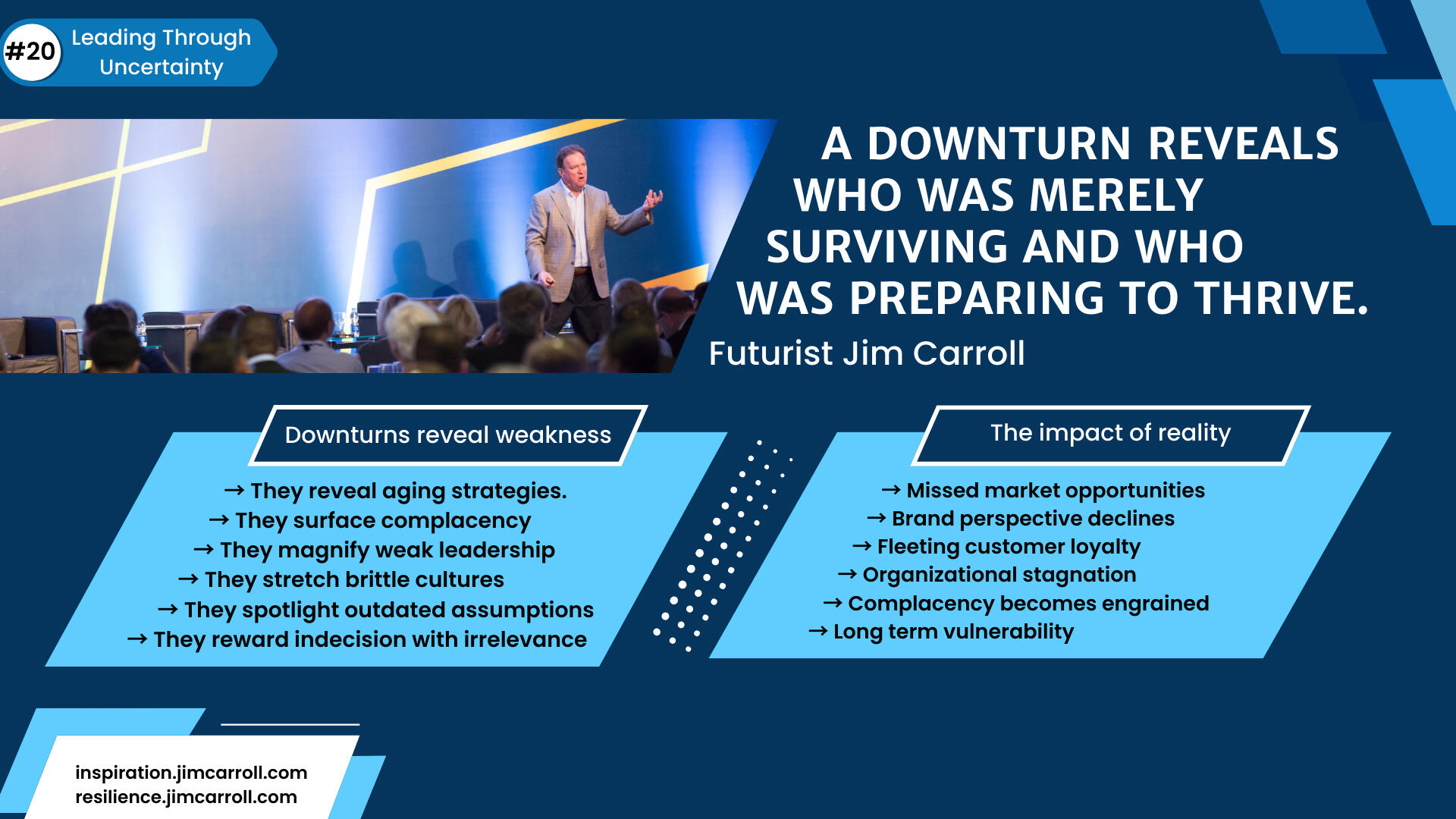
Some organizations stall out. Others collapse entirely. And the reason isn’t usually a lack of potential. It’s paralysis. A lack of organizational agility. A culture that doesn’t support fast collaboration. Weakness in the product or service line. Or any other number of systemic, endemic failures that would have been leading the organization towards failure even during the best of times.In the worst of times, all those weaknesses now becoming glaring, exposed to the harsh light of reality.Downturns don’t just challenge your organization – they reveal it. They surface complacency. They magnify weak leadership. They stretch brittle cultures. They spotlight outdated assumptions and aging strategies. And most dangerously? They reward indecision with irrelevance!I’ve seen this happen in numerous situations. I spent time with Motorola in 2008, just before the great downturn that came later that year. After years of dominance in the mobile phone space, they froze innovation efforts during the financial crisis, cut too deep into R&D, and failed to pivot toward smartphones. Competitors like Apple and Samsung raced ahead. What I saw at the R&D meeting I hosted was an organization that was too focused on regional fiefdoms and budget allocation arguments, and not enough on what needed to be done to align with the reality of the fast technological change surrounding them.Their downfall was all too predictable because the roots of failure were embedded in their culture before the recession hit. The downturn then helped to take them down. The fact is, it wasn’t just a technology failure. It was a leadership failure. Strategy failure. Imagination failure.Predictable failure.Organizations that have innovation failure already baked in get caught at blinding speed when a downturn comes. It leads to predictable consequences:
missed market opportunities because of organizational sclerosis. Companies that delay innovation wait too long to act — and get outpaced by bolder competitors. Nearly 85% of pre-recession growth leaders lose their edge during downturns because they pause while others press forward.
brand and customer decline because they can’t innovate fast enough. Downturns necessitate faster innovation. And yet, organizations that cut marketing, stop customer-facing initiatives or fail to innovate become invisible. Customers drift, loyalty erodes, and relevance evaporates.
organizational stagnation settles in. Without growth, you lose talent. Energy. Confidence. Internal morale crashes. The most talented people leave. Mediocrity becomes the norm. (Hey, I have a book on that!)
long-term vulnerability increases because of complacency. Companies that treat recessions as events to “ride out” — instead of catalysts to “reshape” — are left behind when growth returns.
this complacency becomes the core culture. Over time, failing to innovate doesn’t just impact products or strategy — it rewires your DNA. Risk aversion sets in. New ideas are laughed at. Process overtakes purpose. You become slow. Defensive. Irrelevant.
And in a downturn, those systemic failures send many organizations into a death spiral. Here’s what the research says:
30% of the drop in corporate investment in 2008–2009 came from policy uncertainty
Indecision reduces GDP by as much as 3% during recessions
Companies that invested strategically during downturns outperformed their peers by 30% in the recovery
In other words: action has a cost — but inaction has a much bigger one!All this means that you can’t just have a mindset to try to survive the downturn – you’ve got to prepare for the rebound. And you won’t be able to do that if you are ill-prepared in the first place. History shows that organizations that don’t build for recovery rarely recover at all because they miss growth windows lose top talent, fall behind on transformation, and begin to shrink while their markets shift.The damage may not be visible now — but it compounds.Slowly. Quietly. Fatally.That’s why back in 2009, in one of these posts, I wrote: “The greatest mistake any organization can make right now is to do nothing.”So what can you do instead?
Cutting costs? Fine. But don’t cut your future.
Stressed? That’s a signal to simplify and reinvent.
Worried? Good — channel it into decisive movement.
Your competitors are waiting, too. You don’t have to outrun the economy — you just have to outrun them. And that means:
chasing your growth vision
protecting your innovation budgets, not cutting them
re-skill your team for future skills in anticipation of an upturn
streamline, simplify, refocus – rethink everything
and acting boldly, with speed and intent
A recession isn’t a reason to shrink.It’s a reason to rethink.And if you want to be ready for what comes next — you’ve got to move while others pause.
#21 - May 6, 2025
When the world slows down, winners speed up
Here’s the truth: downturns don’t slow the future. They compress it. They intensify it. They accelerate it.When the world slows down, winners speed up. Downturns don’t delay the future—they accelerate it.With that being the case, speed isn’t reckless. In a recession, it’s your superpower. That’s because, during a downturn, it’s not just the ideas that matter, it’s how fast you move on them.In times of uncertainty, there’s an instinct to slow down. Pause. Delay decisions. Wait for clarity.But history—and recent experience—shows that’s exactly the wrong move. When the environment slows, the smartest companies speed up.
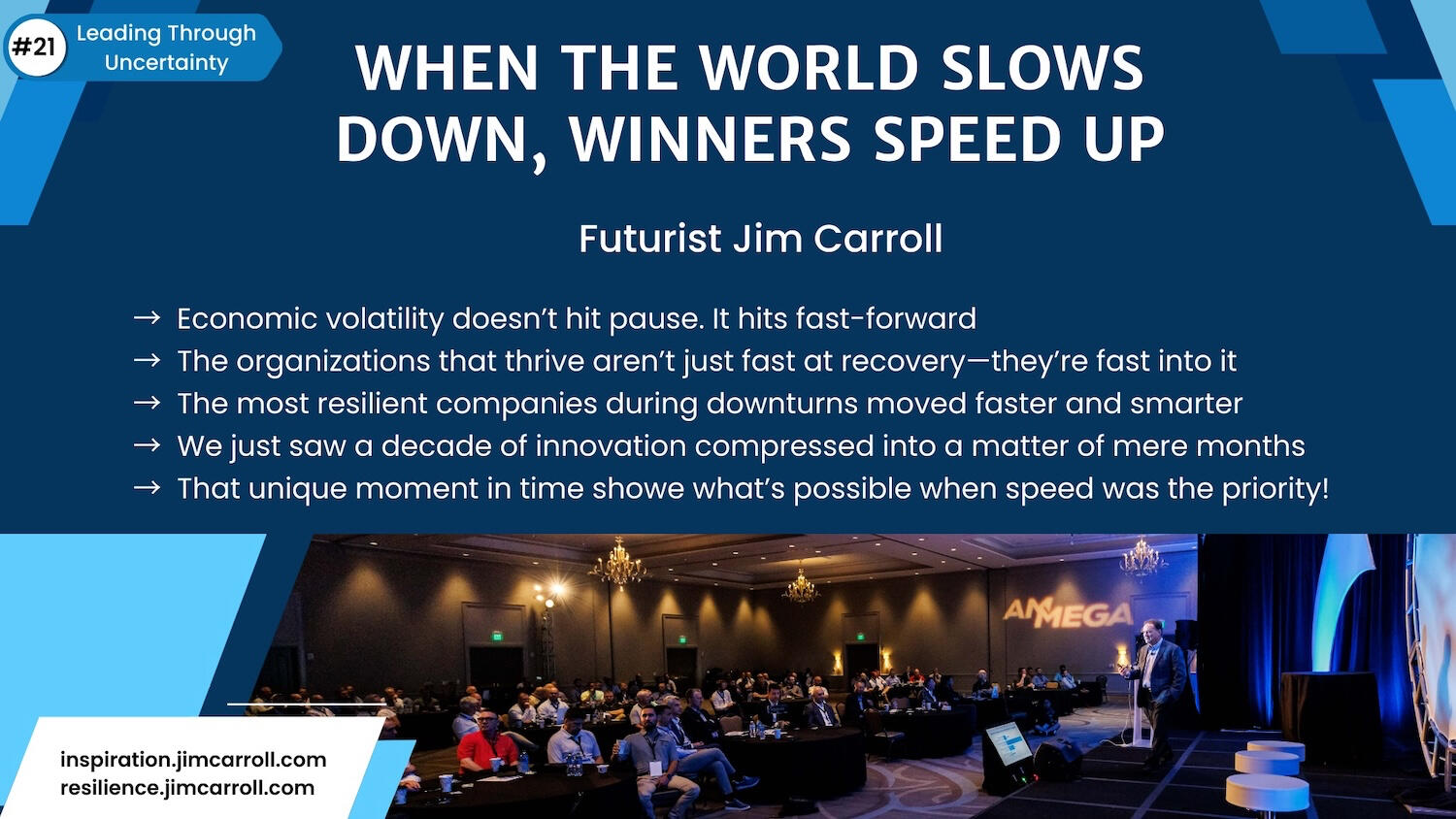
We just witnessed that reality on a global scale in the last few years as the pandemic took hold. If you think back to those first few months, the fact is we compressed ten years of change into just six months. Retailers became digital-first overnight. Healthcare embraced telemedicine in an instant. Manufacturers pivoted supply chains on a dime.So what happened that allowed for this? Major trends accelerated as organizations learned something new about speed! Agility and flexibility became critical because business models shifted faster. Customers changed quickly as people became more adaptable to new interaction methods! Overall, corporate cultures that were once used to working slowly had to embrace speed – with the result that the attitude ‘it can’t be done!’ disappeared, decision-making paralysis disappeared, the slow structure was put under a microscope, old barriers to new ideas disappeared, and “get it done” became the rallying cry!It was a fascinating time since it showed what true organizational agility looks like. Necessity didn’t just breed invention—it demanded acceleration. The rallying cry wasn’t “What if?” It was: “What’s next—and how fast can we make it real?”That wasn’t an isolated circumstance though, because history shows that speed wins in uncertainty. Research from multiple downturns tells the same story: Resilient companies move faster. They make bolder decisions. They simplify governance. They respond rapidly to cost shifts and market shocks. They act while others analyze. They reorganize for velocity and enable frontline decision-making. They accelerate when others stall.And that gap compounds quickly. McKinsey calls it “increasing the metabolic rate of the organization.” In simpler terms: get faster—or fall behind. Speed is a superpower, and decades of analysis confirm it—resilient companies don’t just survive downturns. They move faster than their competitors, and that velocity compounds into outperformance.Here’s what the research shows: Resilient companies that outperformed peers during macroeconomic crises were able to move faster. During the “Great Recession,” they cut operating costs by $0.50 for every $1 of revenue decline, while nonresilients saw costs rise. A defining trait was their ability to improve EBITDA margins—faster.These speed gains didn’t stop once things stabilized. In the recovery, they continued to accelerate, cutting costs faster per revenue dollar. They increased leverage sooner and smarter—while others played catch-up. They made fast and bold moves to drive productivity gains. Their playbook relies on accelerated decision-making as a core strategy. Simplifying operations wasn’t just about efficiency—it was about moving faster. Top leadership teams operated differently—boosting the metabolic rate of decisions.Speed became a strategic asset—enabled by decision-making structures that balance urgency and insight. They acted promptly—and often ahead of competitors. Long cycle times? They reacted even faster to offset costs and drive change. Business resilience was tied to agility and innovation. The ability to adapt quickly became a clear market differentiator. Fast responders gained ground; slow ones slipped. Resilient leaders cultivated a culture where teams could experiment, fail, and adapt fast.The message was clear: change waits for no one. To thrive, you must operate at lightning speed. And above all—leaders built high-cadence teams focused on seizing opportunity in real-time.As a futurist, I’ve watched this pattern play out repeatedly: 2001. 2008. 2020. Each crisis was a stress test. And each time, a handful of companies pulled ahead—not by being cautious, but by being bold and fast. Lots of people don’t understand how important this is – and leads to the mistake many organizations make all too often. They think speed is risky. But in today’s high-velocity economy, slow is the true risk.And here’s the biggest thing we’ve learned. The recovery that inevitably follows favors the fast. Resilient companies don’t just move faster in the crisis—they rebound faster in the recovery. While others are still forecasting, they’re already executing. They’ve built the muscles of momentum.They’re not asking, “When will things return to normal?” They’re saying, “This is the new normal, and we’re already ahead of it.”It comes down to this: Right now, you’re making decisions that will define your post-downturn trajectory.Ask yourself:
are we simplifying decision-making to increase speed?
are we empowering teams to act in real-time?
are we using volatility to break down bureaucratic barriers?
are we rewarding speed of learning over perfection of planning?
Because one thing is certain: the winners of tomorrow are already moving faster today.
#22 - May 7, 2025
The faster you accept the reality of your situation, the faster you advance
Progress in a time of uncertainty begins the moment you stop waiting for the old world to return, and start preparing for the next one.This is where the idea of the '7 Stages of Economic Grief' comes in. Much like the stages of personal grief, organizations often move through a predictable cycle during economic downturns.
Understanding these stages, and accelerating through them, is key to resilience.

Understanding these stages, and accelerating through them, is key to resilience.
Shock: Initial disbelief and paralysis in response to sudden economic signals - plummeting markets, layoffs, uncertainty. Decision-making halts.
Denial: A refusal to accept that the downturn will last or have real consequences. Leaders believe "this will pass quickly" or "we’ll be fine."
Anger: Frustration emerges—at markets, governments, internal dysfunction. Blame takes the place of action.
Bargaining: People start seeking stop-gap solutions or temporary fixes instead of long-term strategic moves. "If we just cut this budget…"
Depression: Morale sinks as a realization settles in that the downturn is real and will last for a while. Talent leaves. Innovation slows. The organization loses momentum.
Acceptance: Reality is finally acknowledged. New strategies are discussed. Leaders begin to plan instead of panic.
Hope: Action resumes. Ideas restart. Teams regroup around future-oriented strategies.
Great leaders don’t stall in grief—they lead their way through it straight into acceptance and hope. Realize this - you can’t build the future if you are in the denial, shock, anger, or bargaining phase, because none of this creates momentum. Action does.Recovery belongs to those who race through the grief to begin moving forward.That's why you need to quickly lead your team through the fog of the grieving process when a downturn begins. While others pause in paralysis, your job is to light the way forward. The best leaders do this by helping everyone move with speed through doubt and into direction. It’s not the recession that breaks companies—it’s how long they stay stuck in it.What happens if you stay stuck in the anger, shock, or denial phase? The state of absolute paralysis when a recession looms and idea factories are being turned off! The result is that they don’t just enter a potential economic recession, they go into an idea recession.But the winners who achieve growth in a recession don't think like that. History shows us that it’s those organizations that move to the hope and acceptance phase that eventually win in the race to the future.Here are some facts to get you moving. History tells us that only 10% of organizations become breakthrough performers during a recession – because they decide to double down on innovation and opportunity despite lingering and pervasive uncertainty! 60% are simply marginal performers during a downturn, undertaking the bare minimum to get by. The remaining 30%? They either don’t make it – they go bankrupt, are bought out, or disappear altogether.And it's the organizations that get stuck in the “shock” and “denial” phase who are the laggards, who are among that 60% or 30%.Think, though, about the innovation leaders – the 10%! They’re prepared to keep their idea factories running, innovation on full throttle, bold goals in their vision, big ideas floating about. They know that even though vast sections of the economy are tanking, there are still growth markets and opportunities to step ahead of your competitors. There are opportunities to attack new markets, streamline operations, build new brands, and grab customer mindshare in new ways.There are plenty of opportunities to turn ideas into innovationSo, where will you place yourself on the 7 stages when things get tough?It all depends on where you want to be as we come out of the downturn.
#23 - May 8, 2025
The smartest strategy in a downturn? Say no to the narrative!
Your growth story begins the moment you decide not to take part in someone else’s pessimism.An economic downturn? Just refuse to participate! In an era of panic, the boldest act is to opt out of the fear. The future doesn’t belong to the cautious—it belongs to the courageous.With that thought in mind, know this – winners don’t wait. They create. Recessions don’t kill opportunity. Mindsets do. The companies that shape tomorrow are the ones inventing it today—despite the headlines. That’s why the smartest strategy is to ‘just say no‘ to the narrative.After all, if everyone’s playing defense, the game is yours to win on offense. The path to growth starts with rejecting the crowd’s caution!
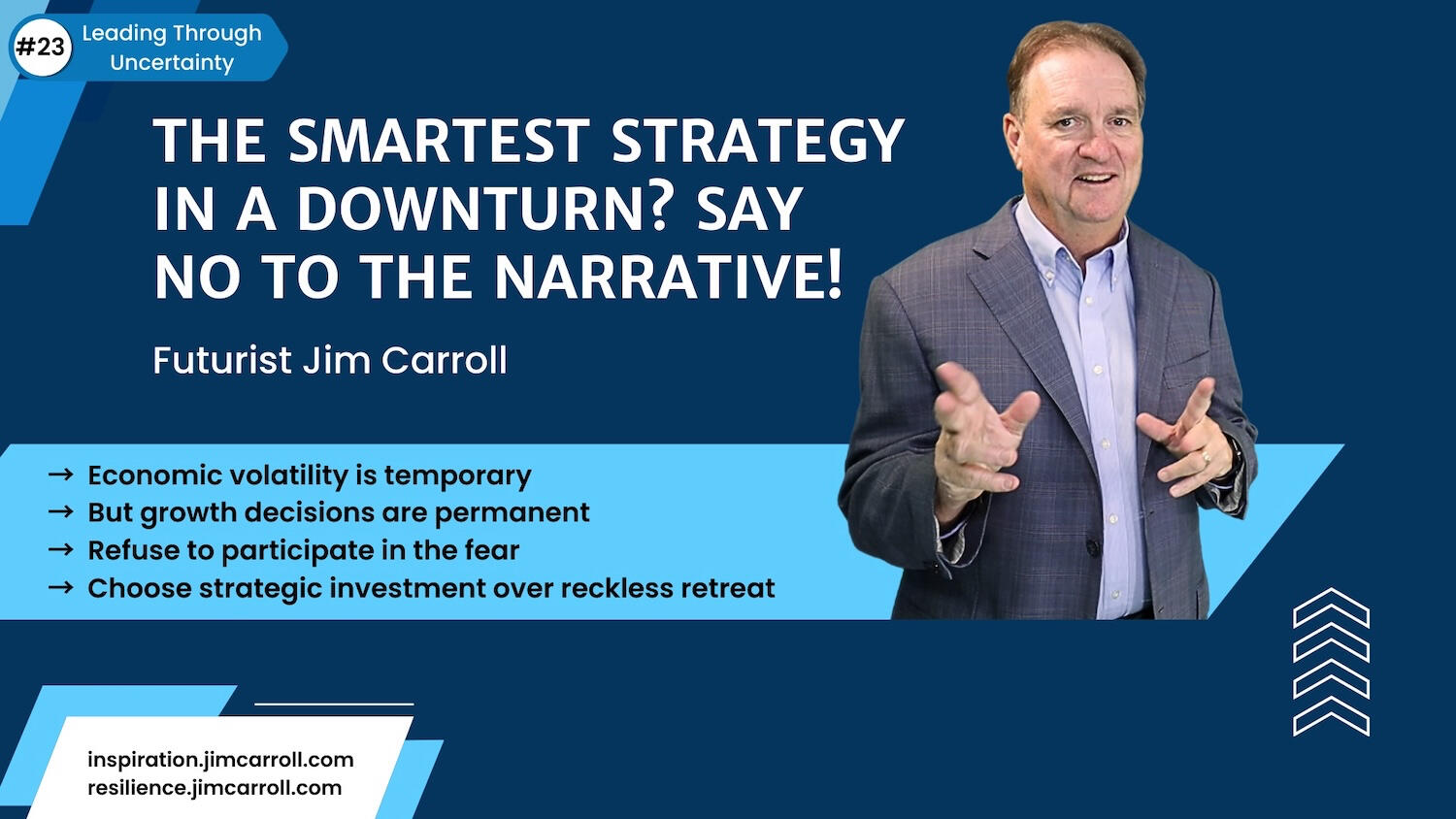
You can’t shrink your way to tomorrow. The organizations that pull back on the initiative to move forward will stay back. Those that move forward now are the ones we’ll be talking about tomorrow. That being the case, mindset is the first move. A downturn is a test of belief.That’s why one of the first things you can do is to dance in the rain. Make the best of a bad situation. Do what you can do despite trying circumstances. Stay focused on your goals despite the fuzziness that surrounds you.Opting out.To opt out is to choose not to participate in something.Right now, the conventional wisdom – the wisdom of crowds – always seems to be that in a period of economic uncertainty or a downturn, the best thing to do is to hunker down, scale back, slow down, take it easy, be cautious, reduce spending, defer our actions, wait it out, take things slow, put things on pause.And that is just plain, well, the wrong thing to do! History tells us so – because those who choose to opt out of conventional wisdom are those who win.In recent years, we’ve seen what happens when some choose not to participate in a recession, economic downturn, or whatever we want to call a period of economic uncertainty. They have determined that it’s important to focus on the long-term goal, not the short-term volatility.What we know from previous downturns is this: those who chose to opt out experienced growth during the downturn that others did not see. Not only that, but their rate of growth after the downturn was greater than those who chose the traditional path of cutting back. Bottom line: long-term winners are those who chose not to participate in a downturn!It seems simple but is pretty critical – when uncertainty stares you in the face, double down on innovation and transformation, and refocus on the long-term view!For example, here are two key things we learned from the 2008-09 global economic meltdown.
first, ‘winners’ grew at a 17% compound annual growth rate (CAGR) during the downturn compared to 0% among the ‘losers.’
second, those ‘winners’ locked in gains of 13% CAGR in the years after the downturn compared to the ‘losers’ stalling at 1%.
In other words, by opting out of the common narrative – ‘it’s a recession, cut back, hunker down and make sure you ride it out – and by choosing instead to go into the future full throttle, the ‘winners’ emerged much better positioned for that future.It’s a powerful lesson.The story continued beyond that recession. A Grant Thornton survey in 2021, when some economic clouds were floating about, found that 50% of major organizations planned to double down on innovation if there was to be a downturn They didn’t intend to just retrench and try to ride it out; most were counting on continued investment in technology and innovation to push them through.As the study notes:Most companies believe a recession is coming, and the key is to plan now – then invest in, innovate and execute on the core business during the downturn, which will position companies that do to dominate the recovery. Companies that approach a recession with the discipline to control expenses and manage cash, but with a matching vision to align ongoing investment with strategy and opportunity, can win the downturn rather than merely surviving it.”This is a real mindset shift from conventional wisdom. What were the differentiators identified in the study?Those who fail to thrive in a downturn do these things:
they perform heavy cost-cutting
they scale back of R&D
they see a lot of quality talent lost due to cutbacks
they stray out of their core business to try to find a path forward
they take a wait-and-see approach
Those who achieve significant CAGR despite a downturn do these things:
played on the offensive but selectively
they accelerated R&D spend
they focused sales efforts on top customers
they maintained or boosted marketing
they focused on digital customer experience
So what do you do?Refuse to participate in the fear. Choose strategic investment over reckless retreat. Reignite your innovation engine. Rethink your markets, your offerings, and your talent. Focus on transformation while others are stuck in survival.Remember: economic volatility is temporary, but growth decisions are permanent.Opt out of the recession – and into the future.
#24 - May 9, 2025
While others wait for normal, the bold invent what’s next
Know what you don’t know about tomorrow.Find out what you need to know.Know it.Then do it.That’s your resilience playbook right there!That’s how you grow into your future.If there’s one thing this series – and soon to be a book – has emphasized, it’s this: the future isn’t waiting for you to catch up. It’s already in motion. And in times of volatility, downturn, or disruption, the winners are those who don’t just react to change—they run toward it.The single most important question you should ask yourself as a leader, strategist, or builder of tomorrow is simple: Where’s the growth? What’s the opportunity? Where do you find your future?
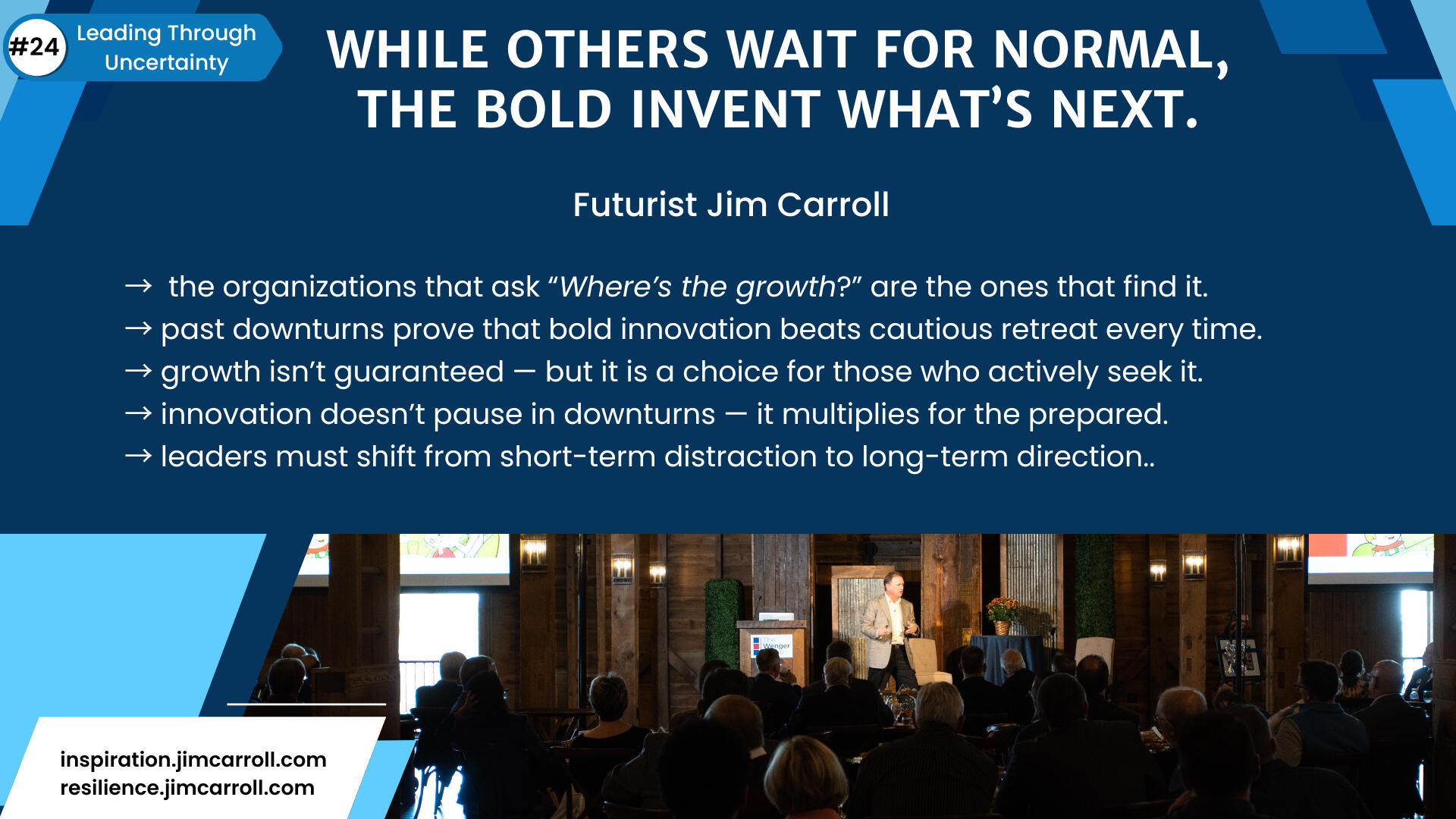
And the simple fact is – the future is already here. It surrounds you. You just need to see it and act on it. At every single moment, new opportunities are unfolding around you. The key is training yourself to see them. That means:
looking to the edges: Trends don’t begin in headlines—they begin in hackerspaces, niche communities, small research labs, and startups. History shows that the future first reveals itself in unexpected places.
looking where others aren’t: True innovation comes from unconventional thinking. Study niche scientific breakthroughs, obscure tech forums, and emerging markets.
spotting trends hiding in plain sight: Many of tomorrow’s biggest disruptions are already here, just under-appreciated. No-code tools, energy storage breakthroughs, or micro-manufacturing weren’t obvious when they started.
projecting yourself forward: Look back from the future. Where would you wish you had acted sooner? Now act.
finding the collisions: Hyperconnected opportunities happen at the intersection of ideas. AI + agriculture. Blockchain + logistics. Gaming + architecture. Find the overlaps.
challenging the skeptics: Trends often dismissed as fads are the ones that end up transforming industries in the long run, not the short term. Cloud computing. Green energy. AI. History proves it again and again.
Speaking of spotting trends and embracing what’s next, here are 50 major mega-trends that are shaping our future right now. Every single one of these trends provides growth opportunities. They don’t disappear because of uncertainty, a downturn, or a recession. That’s the funny thing about trends – they’re the energizer bunny of tomorrow because they just keep going and going and going.
Electrification Revolution: The rapid shift from combustion engines to electric vehicles, integrated charging infrastructure, and the decline of traditional automotive players unable to adapt to this technological transformation.
Energy Decentralization: Evolution from centralized power grids to interconnected two-way energy systems, with integrated home microgrids combining renewable sources, storage, and smart management becoming billion-dollar industries.
Healthcare Transformation: Movement from reactive treatment to preventive and predictive medicine through constant bio-monitoring, connected pharmaceuticals, DNA-based approaches, and AI-assisted diagnostics.
Agricultural Reinvention: Emergence of connected farming, vertical farming in megacities, robotic farm management, data-transmitting crops, and 24-hour autonomous farming operations changing our food systems.
AI-Driven Automation: Expansion of machine learning beyond human-written code to self-learning systems affecting every industry, creating massive productivity shifts and entirely new business models.
Extended Human Longevity: Dramatic increases in lifespan through medical breakthroughs including lab-grown replacement organs, brain augmentation technology, and bionic implants.
Next-Generation Manufacturing: Shift from mass production to mass customization, with 3D printing (including biological materials) enabling personalized production at scale.
Embedded Intelligence: Proliferation of smart, connected objects in everyday life – from clothing to sports equipment to home fixtures – creating omnipresent sensing and feedback networks.
Transportation Autonomy: Transformation from human-operated vehicles to self-driving, interconnected transport systems that communicate with infrastructure and each other.
Business Model Acceleration: The increased pace of business model obsolescence as digital disruption compresses innovation cycles, with successful companies of today facing Kodak/Blockbuster-style irrelevance without continuous reinvention.
Knowledge Explosion: Exponential growth in information volume (particularly in fields like medicine), creating both opportunities and challenges in knowledge management and application.
Just-in-Time Systems: Evolution of insurance, education, and other services from static models to real-time, data-driven, personalized approaches adapting continuously to changing conditions.
Human-Technology Integration: Deeper merging of technology with human biology through implants, augmentation, and monitoring, blurring the boundary between person and device.
Geopolitical Realignment: Major shifts in global economic and political power, with the rise of Africa as an economic force and potential democratic instability in previously stable nations.
Post-Physical Retail: Fundamental restructuring of consumer commerce beyond traditional shopping models, with physical spaces being reimagined for different functions.
Resource Optimization: Development of technologies focused on sustainability and efficiency in response to environmental pressures, including renewable energy dominance over fossil fuels.
Connectivity Ubiquity: Exponential expansion of network capacity (from megabits to yottabits) enabling previously impossible applications and services through always-on, high-bandwidth connections.
Digital Twinning: Creation of virtual representations of physical entities (from farms to organs) allowing for simulation, optimization, and control at unprecedented levels.
Career Obsolescence and Creation: Rapid elimination of traditional jobs coupled with the emergence of entirely new professions and career categories not yet imagined.
Security Imperatives: Elevation of cybersecurity from technical concern to existential business risk requiring board-level attention as digital dependencies deepen across all sectors.
Personalized Biological Systems: The shift toward individualized health and nutrition based on personal DNA profiles, including custom food plans, personalized medicine, and DNA-specific organ/tissue development.
Democratized Advanced Technology: High-tech tools becoming accessible to average consumers (like affordable DNA sequencers at dollar stores), enabling innovation from previously excluded populations.
Intergenerational Expansion: Unprecedented longevity creating new social dynamics with the possibility of many living generations simultaneously coexisting, requiring new models for family relationships and generational wealth transfer.
Digital Identity Evolution: The transformation of personal representation in digital spaces, from avatars to deep-fake personalities, creating new forms of entertainment, interaction, and identity management.
Regulatory Disconnection: Growing gap between the speed of technological change and regulatory frameworks’ ability to adapt, creating both challenges and arbitrage opportunities in governance models.
Material Science Revolution: Exponential growth in new chemical substances and materials (from 19 million to 5 billion by 2100) enabling previously impossible products and solutions across industries.
Cognitive Enhancement: Development of technologies specifically focused on brain health, function and augmentation, similar to how heart health was transformed in the 20th century.
Meta-Knowledge Systems: New approaches to managing rapidly changing information landscapes, including just-in-time learning and solutions to problems like digital decay (link rot).
Experiential Transformation: Revolutionary changes in how humans experience reality, from being able to perceive the world as other species do to entirely new sensory interfaces.
Urban Reimagination: Fundamental restructuring of city functions and spaces as megacities evolve, with new integrated systems for food, energy, transportation, and living spaces.
Infrastructure Intelligence: Evolution of physical infrastructure (roads, buildings, utilities) from passive to active systems that generate power, collect data, and interact with vehicles and devices.
Generational Value Shifts: Accelerated change as change-resistant demographics (like baby boomers) exit the workforce and economy, allowing for more rapid adoption of new paradigms.
Environmental Technology Integration: Development of technologies that simultaneously address climate challenges while creating economic value, like electricity-generating windows and sustainable alternatives to energy-intensive systems.
Temporal Flexibility: The decoupling of activities from traditional time constraints (like 24-hour farming), creating new operational models and efficiencies across industries.
Data Physicalization: The embedding of data collection and transmission capabilities into previously analog objects and environments (crops, sporting equipment, clothing), creating entirely new information streams.
Anticipatory Design: Systems designed to predict needs and respond before traditional triggers occur, from maintenance to healthcare to consumer experiences.
Micro-Autonomous Systems: Proliferation of tiny specialized robots and drones for specific functions (crop tending, pollination, inspection), creating swarm-based solutions to complex problems.
Knowledge Obsolescence Management: New approaches to handling the accelerating rate at which established knowledge becomes outdated, affecting education, training, and expertise certification.
Digital-Physical Convergence: The blurring boundary between virtual and physical worlds through technologies like heads-up displays rather than fully immersive “metaverse” experiences.
Legacy System Transformation: The reimagining of established structures (like shopping malls) for entirely different purposes as their original functions become obsolete.
Digital Trust Infrastructure: Development of systems, technologies, and governance models to address growing security vulnerabilities as digital dependencies deepen, moving cybersecurity from a technical afterthought to a foundational requirement.
Sovereign Technology Ecosystems: Nations and regions developing self-sufficient technology stacks and supply chains in response to geopolitical tensions, creating parallel technology ecosystems.
Bio-Digital Convergence: The integration of biological processes with digital technologies, creating hybrid systems that leverage the strengths of both domains (like DNA-based computing or bio-reactive materials).
Ambient Intelligence: Evolution of computing from device-based interfaces to omnipresent, invisible systems embedded throughout environments that respond to presence, voice, and gesture.
Temporal Commerce: Business models built around time efficiency, anticipatory delivery, and frictionless transactions (like vehicle dashboard payment systems), prioritizing convenience and speed.
Hyper-Personalization at Scale: Systems capable of mass delivery of individually customized experiences, products, and services based on comprehensive personal data profiles.
Analog Renaissance: Selective return to physical, tactile, and non-digital experiences as premium alternatives in an increasingly virtual world, creating new value for intentionally non-digital products and services.
Human Interface Evolution: Transformation of how humans interact with technology, moving beyond screens and keyboards to neural interfaces, gesture control, and ambient voice systems.
Abundance Management: New approaches to handling post-scarcity dynamics in specific domains (like information, renewable energy, or computational capacity) while addressing continued scarcity in others.
Cross-Disciplinary Innovation: The most valuable breakthroughs increasingly occurring at the intersection of previously separate fields, creating premium value for integration skills and systems thinking approaches.
These aren’t distant sci-fi scenarios – they’re happening now, creating massive opportunities for those paying attention. When you look at these mega-trends, you see the blueprint for what’s coming next.We’ve seen the importance of developing foresight, accelerating decision-making, and embracing the edge of innovation as core competencies of resilient leadership. These habits fuel your ability to see opportunity where others see only chaos. But it’s developing the ability to look further despite the uncertainty around you that will define your opportunity.Is there a future out there? Definitely yes, but a constant drumbeat of negative news can cause people and organizations to lose sight of what will happen. That’s why you should focus on accelerating your insight into some of the key trends that will impact industries, organizations, and careers in the next few years,What underlies all these trends? Despite a downturn or recession, knowledge still accelerates. The global idea machine still reverberates. Big thinkers still think of how to solve big challenges. Inventors still invent. Dreamers still dream. Innovators still innovate. Doers still do. Change agents can still affect positive change.And most important? Optimism will always overcome pessimism!No barrier to the future is insurmountable with the right determination! The simple fact is this.
New Markets Will Always Emerge: Entirely new industries and product categories are being created every year. Think clean tech, longevity science, and immersive media.
Innovation Will Always Define Market Leaders: Companies that continue to innovate in customer service, product design, and experience win regardless of economic cycles.
Tech Will Always Accelerate and Never Slow Down: From medical devices to smart cities, every sector is becoming a tech sector.
Agility Beats Size: Supply chains are being reinvented. Fast beats big. Responsive beats rigid.
Global Idea Cycles Are Speeding Up: Innovation spreads globally overnight. Garage tinkering becomes an industry transformation in months.
Generational Shift Means New Mindsets: Younger generations don’t wait. They create. Their digital-native mindset changes everything.
Information Velocity Compresses Recovery: People bounce back faster now. Acceptance arrives sooner. Innovation moves quickly.
Transformative Thinking Drives Results: Those who think big and bold during downturns lead the upturns.
You need to look to these ideas, which will allow you to ignore the noise and follow the signals. Here’s what I know – every single time that volatility has raged, markets have melted down, and a downturn settled in – innovation was still booming. Real leaders, following trends, doubled down on investment, strategy, and future opportunity.Growth is not a given – but it is available. And it belongs to those who choose to seek it out, no matter the circumstances. You can’t wait for a perfect moment to act. You need to act in the moment you have.When others hesitate, you move.When others cut, you invest.When others wait for clarity, you create it.That’s where the growth is.Are you ready?
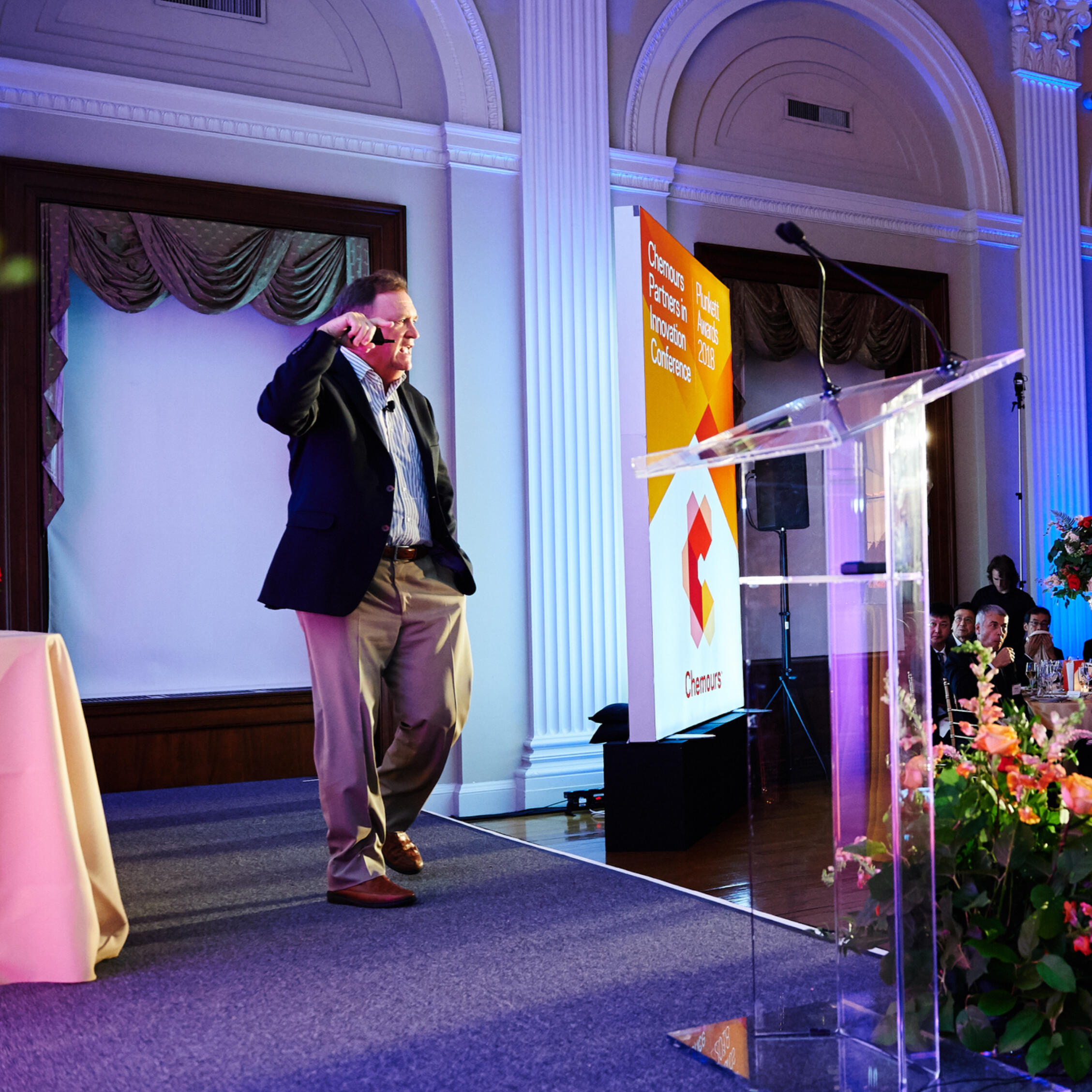
Mindset matters.
Moving Forward
You're frozen in fear with tariffs. The economy is volatile. The market isn't fun. What do you do?Lead your team forward - get them out of their fear.In 2009, Yum! Brands had Futurist Jim Carroll on stage for an audience of thousands in Las Vegas as the market was melting down. Fear was in the room. He spoke about the '7 Stages of Economic Grief,' and why history has taught us that those who moved to the Acceptance phase were the ones who win.Since then, he did dozens of leadership oriented talks about how to move through an era of wild economic volatility. He did the same thing after the downturn of 2001 - and again, through the pandemic.At this very moment, leadership teams are looking for critical insight.
For 3 major economic downturns, I've helped to lead them out of the wilderness. I'll do so again with this one. I've spent time on the topic with organizations like Northrop Grumman, Lockheed Martin, Honeywell, Microsoft, IBM, Nestle, and dozens more. CEO-level events and corporate offsite leadership meetings.Right now, deep leadership insight for teams on how to get through the volatility is a precious resource. Experienced insight matters.

About Jim Carroll
Futurist & Innovation Expert
Futurist Jim Carroll is on a mission to help organizations understand how to align to tomorrow, today.“I help CEOs, senior executives, and association leaders achieve their strategic objectives by aligning them with a disruptive, accelerating future. It’s actionable, powerful leadership insight based on detailed, specific industry trends – delivered within a fast-paced keynote with a compelling motivational style!” – Jim Carroll
Keynote
Leading Through Uncertainty:
7 Ways to Achieve Resilience In an Era of Volatility
Innovative organizations succeed by mastering the pace of the new high-velocity economy. In an era of economic challenge, they develop a relentless focus on chasing opportunity!For more than three decades, Futurist Jim Carroll has shared worldwide key strategies for moving forward through uncertainty

Move forward, not back
Contact Jim
Your issues are critical; your leadership meeting is important; your success with your event is mandatory.You need a battle-tested proven expert who can deliver concise trends-oriented leadership insight.Don’t just take Jim’s word for it. Join other leading organizations like NASA, Pfizer, The World Bank, Mercedes Benz, the PGA, Blackrock, the Wall Street Journal, and even Disney, all of whom arranged for Jim’s insight for a global leadership event or customer meeting – and came away empowered with new insight to take on our faster, more complex world.